Table of Contents
- Ahrefs Brand Radar tracks AI and web visibility, including mentions in ChatGPT, Gemini, and Microsoft Copilot.
- BuzzStream ListIQ uses AI to create precise, exportable media lists directly from Google News results.
- InTheMix.ai shows which sources are cited by Google’s AI, enabling reverse-engineered PR strategies.
- ChatGPT simplifies research, ideation, and campaign support with context-aware, citation-backed answers.
- Hypotenuse AI generates structured, editable press releases via prompt refinement for higher quality output.
- PressPal.ai writes AI-generated pitches and suggests relevant journalists using MuckRack data.
- IdeaMap.ai creates editable mind maps for collaborative content brainstorming and reactive PR ideation.
- Canva Magic Studio offers accessible AI image generation and editing tools tailored for PR visuals.
- Grammarly AI enhances clarity, tone, and readability with real-time suggestions across writing platforms.
- CopyLeaks accurately detects AI-written and plagiarized content, outperforming many popular alternatives.
- DeepL delivers top-rated translations for global PR outreach—best when paired with native proofreading.
- Fireflies AI transcribes and summarizes meetings with GPT-powered chat and Perplexity-based web insights.
AI is here to stay.
It’s time to embrace it.
AI tools can save time and energy, and in many cases, enhance our PR campaigns and workflows.
However, there are over 33,000 AI-powered companies, according to Tracxn as of July 2025. So, how do you even start finding apps that work for you?
Luckily, I tested most of the top tools listed on other ranking posts to save you the trouble. Some tools that other posts discuss are not related to PR, so I’ve removed them.
Then, I broke it down in this post by the tool used for the most relevant task.
Without further ado, here’s my list of the top AI PR tools you need today.
1. Ahrefs Brand Radar for Tracking Brand Mentions
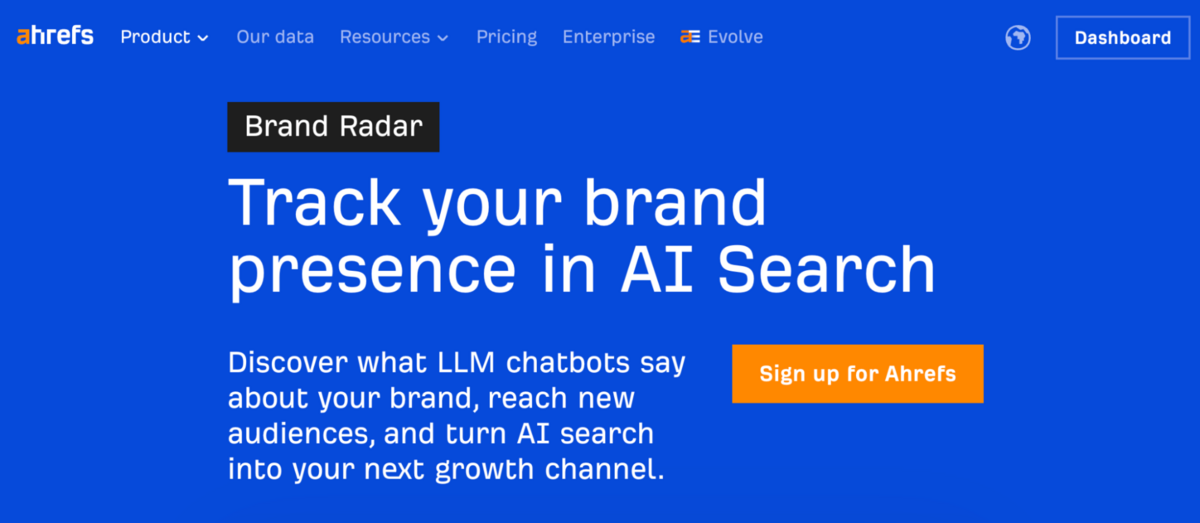
Ahrefs consistently rolls out great tools for modern-day marketers. Their newest endeavor, Brand Radar, helps users track their online visibility across various web platforms and AI tools.
For instance, I can get a snapshot of BuzzStream’s internet footprint over the years based on the number of web mentions:
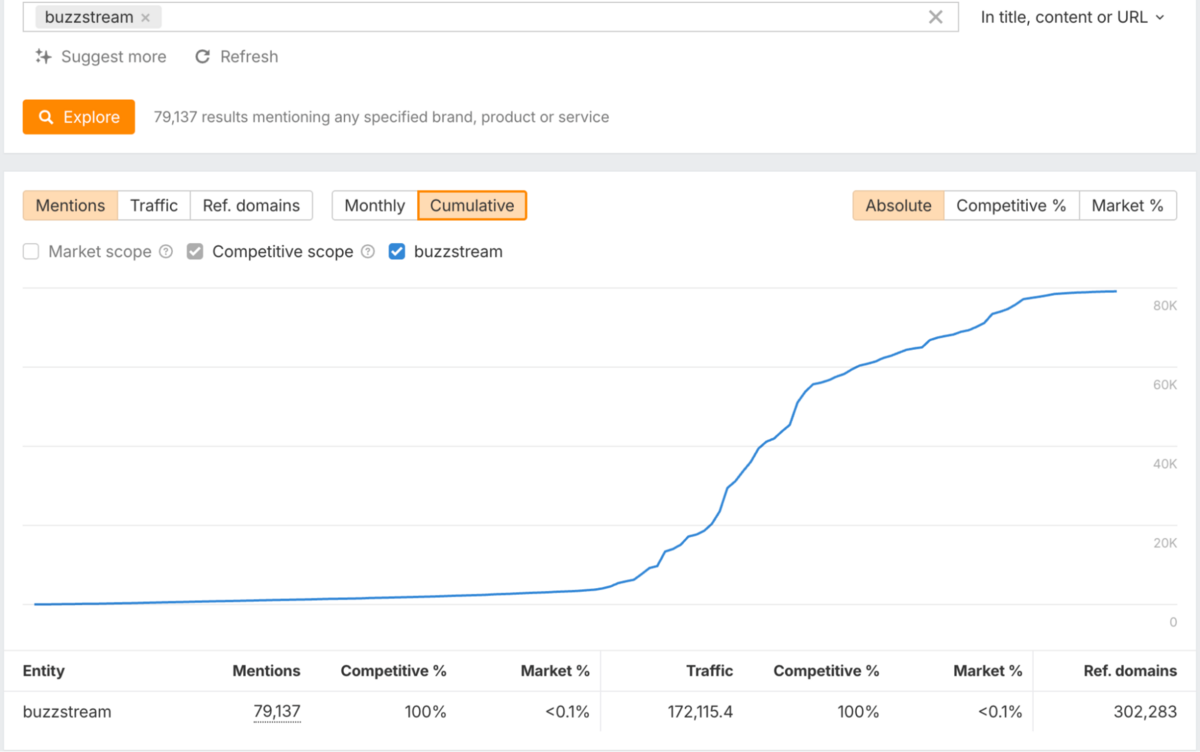
However, I can also examine mentions in ChatGPT, Gemini, Perplexity, AI Overviews, and even Microsoft CoPilot.
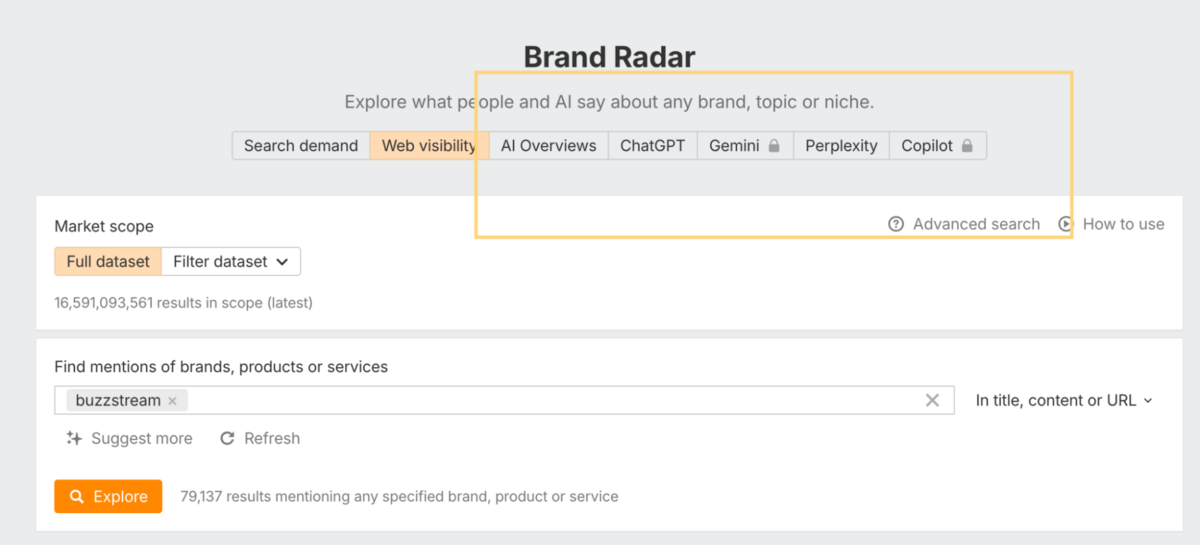
Each look can also be compared to competitors, which helps benchmark so that you aren’t going at it in the dark.
As of writing this (in July 2025), they are still rolling out updates to their database to incorporate more queries to help better track the overall footprint.
For instance, currently, it shows that “BuzzStream” only appears in 21 results in June.
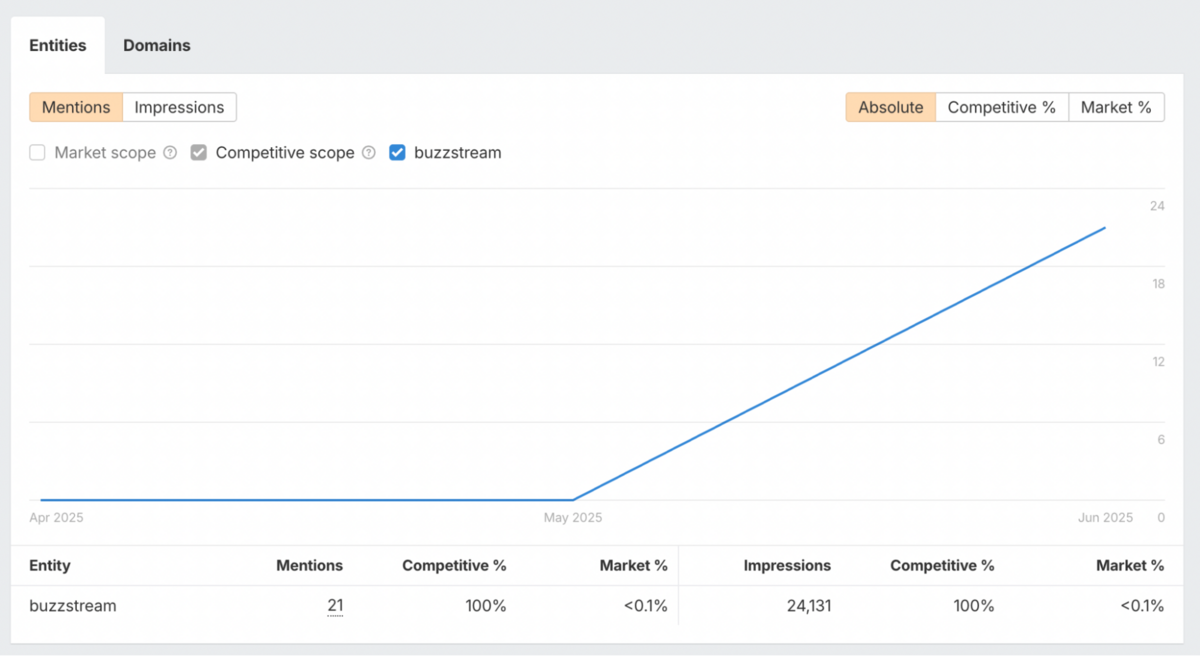
Whereas AI Overviews seems to be a little more up-to-date:
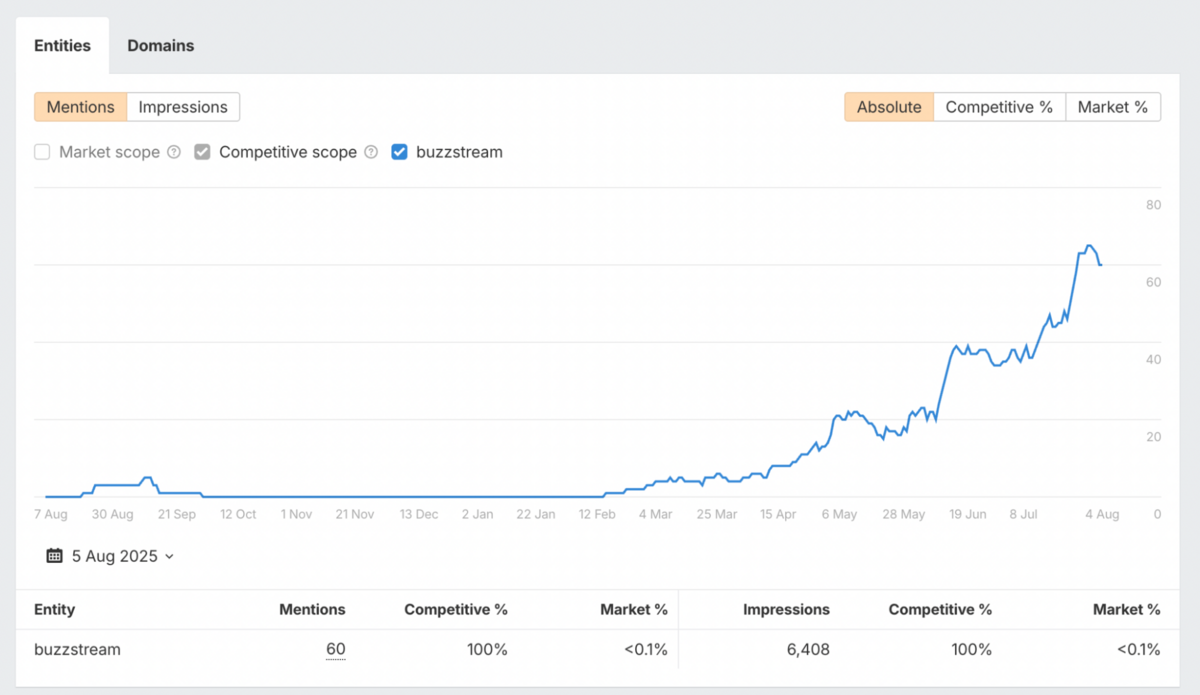
Either way, these new features are a much-needed addition to the Ahrefs toolkit.
Understanding how our brand shows up in AI is now becoming an integral part of tracking PR metrics.
Pricing
Brand Radar is available at the Lite tier, which is $129 /mo, but the AI integrations cost $99-$199/mo extra, depending on which you choose.
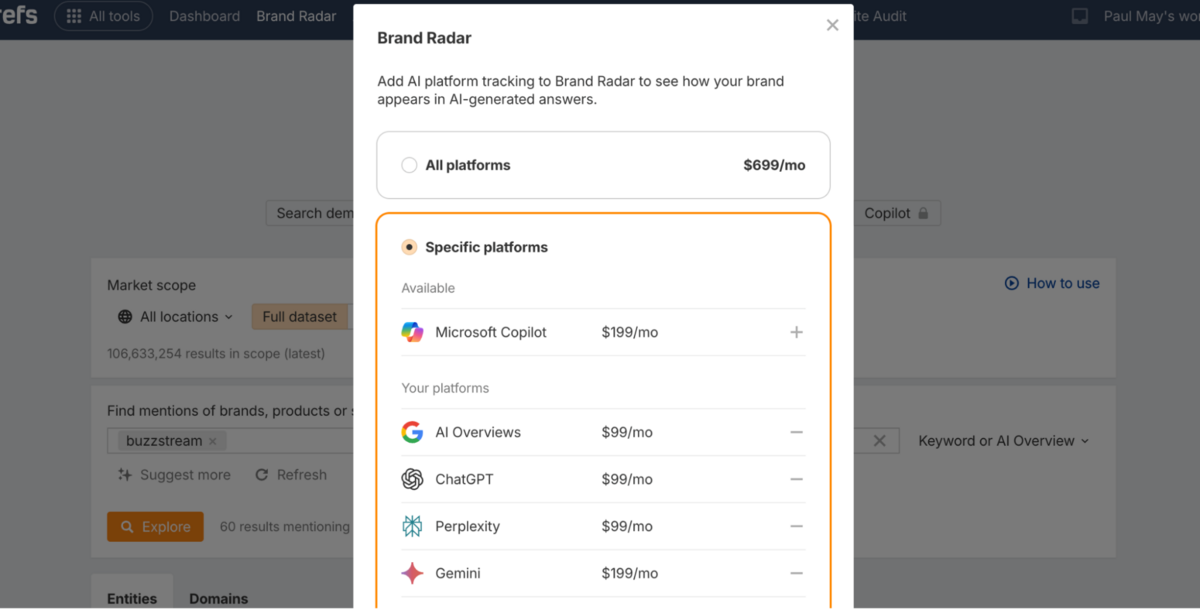
Alternatives
If you’re interested in AI tracking, one of the cheaper alternatives is Waikay.ai.
The tool works in a slightly different way to help you not only understand how your brand gets noticed on GEO, but also to build a plan to increase visibility.
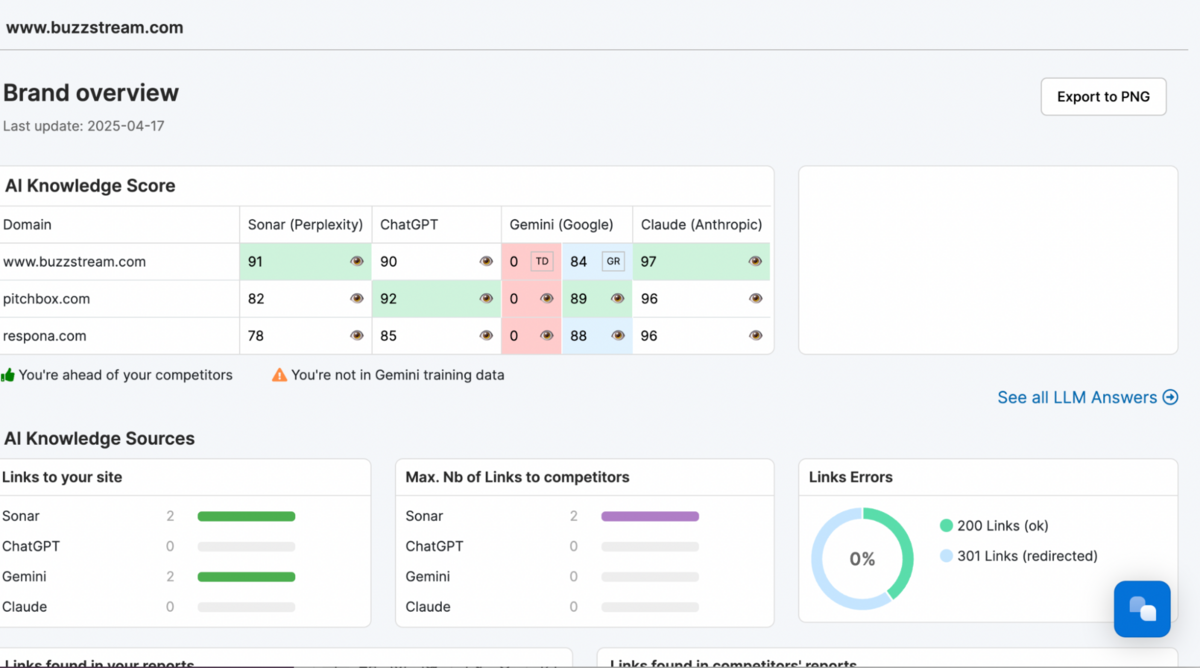
Pricing for Waikay starts at $19.95/mo, then bumps up to 69.95 for the small team plan.
2. BuzzStream ListIQ for AI-Powered Media List Creation
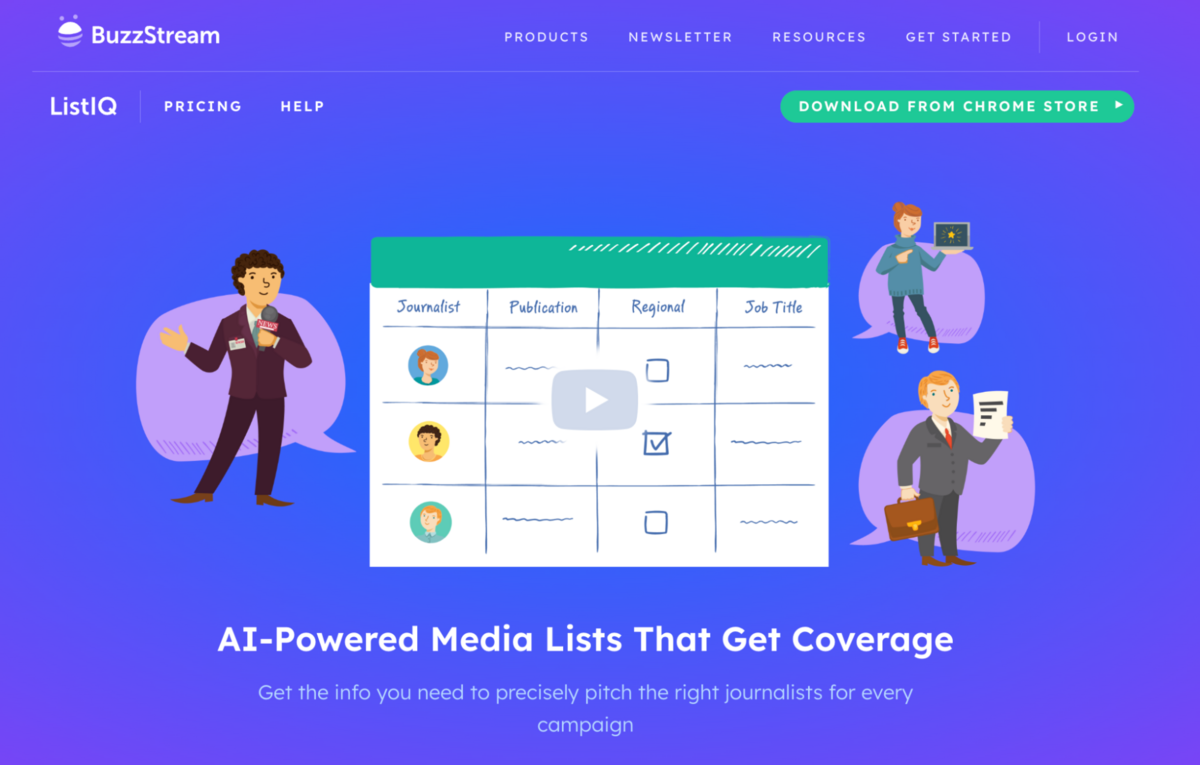
BuzzStream’s new ListIQ is an AI-powered tool that helps you build hyper-targeted media lists instantly from a Google News search.
There are typically two ways to create a media list: using a media database, which is less time-consuming but casts a wide net and lacks targeted precision, or using a targeted approach, which is more time-consuming but provides greater accuracy.
The other way I’ve done it is by using Google News search and finding relevant contacts on the fly, which yields a much more relevant list of journalists, but takes a lot of time to research each article and journalist.
ListIQ has solved this problem for me.
I now build relevant media lists from Google News search at scale in minutes.
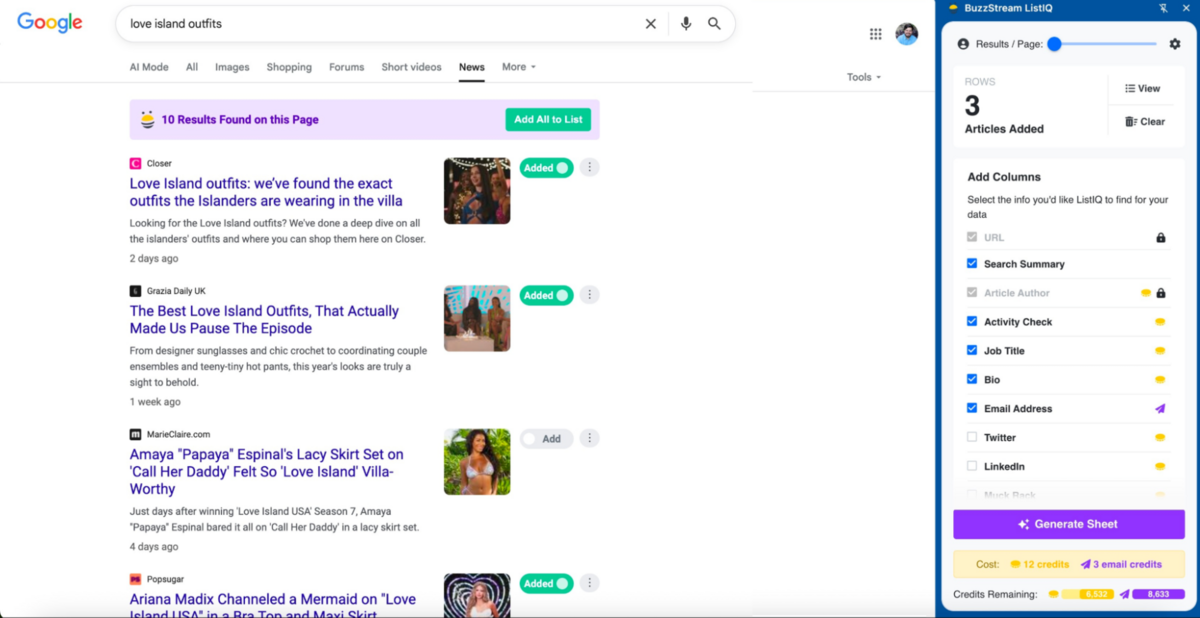
I can select any set of Google News search results and ask ListIQ to find the information I need to add them to my media list, like their job title, email address, bio, and recent articles.
Then it spits it out into a Google Sheet, where I can quickly evaluate each journalist.
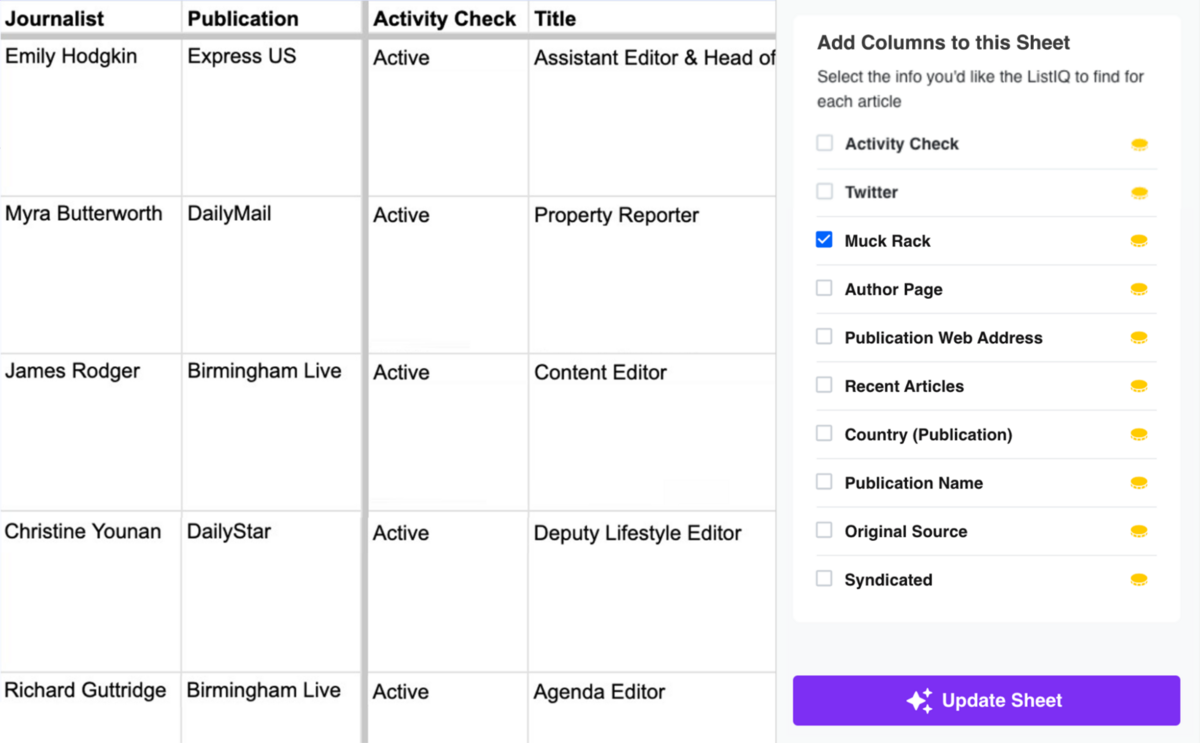
From the Google Sheet, I typically export it directly into BuzzStream and start sending emails, but you can also export the list as a CSV and use it wherever you want.
Pricing
There is a free plan, which provides 20 email credits and 200 standard credits. The first tier is $99/mo for 100 email credits and 1,000 standard credits.
See the pricing page for more information.
3. IntheMix.ai for AI Citation Discovery
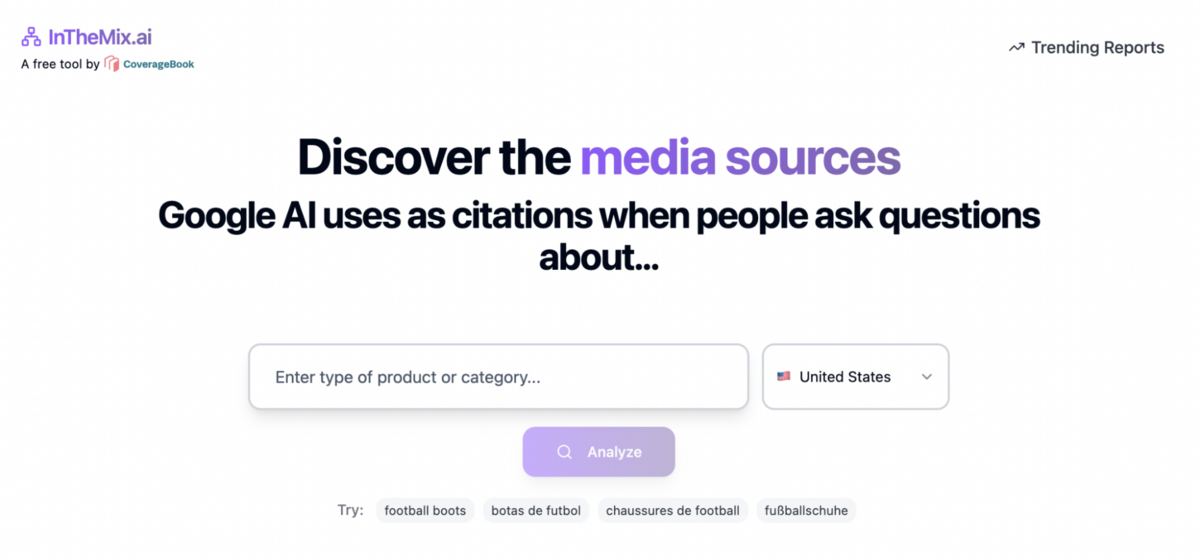
InTheMix is a new, free tool from CoverageBook, created by the same team that developed Answer the Public (back before Neil Patel bought it).
The new tool helps understand the media sources that Google AI uses as citations.
It does this by breaking down your search for a topic or category into five queries:
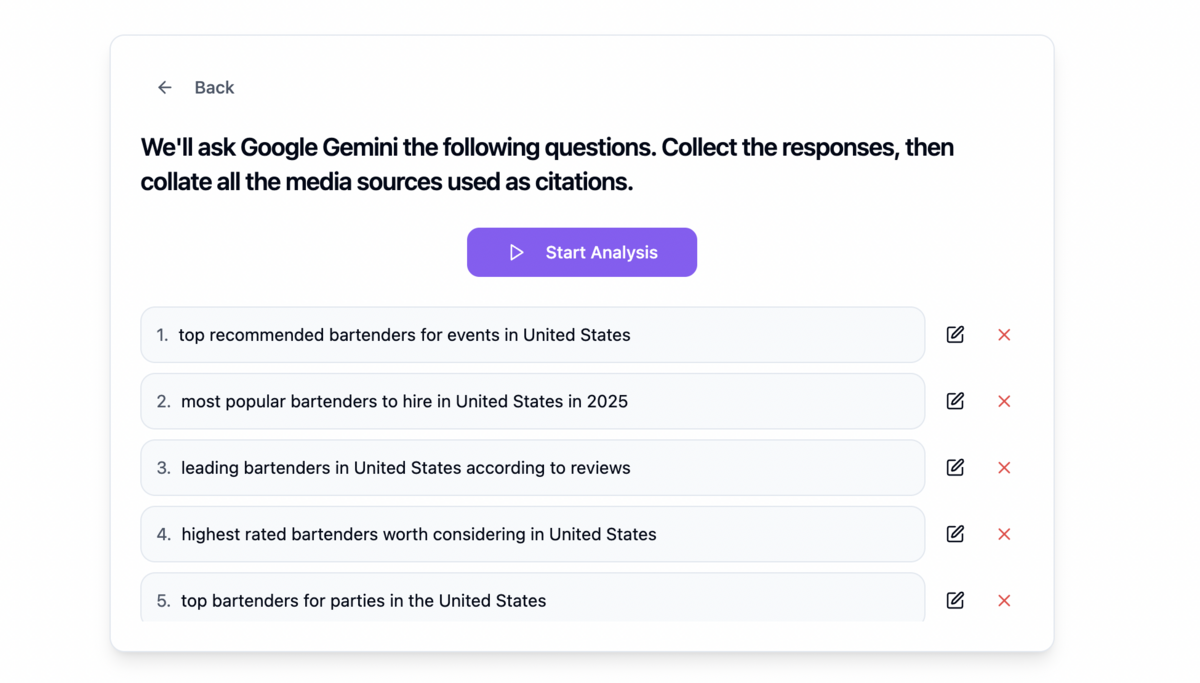
Then it will tell you the different sources and the queries in which they were mentioned.
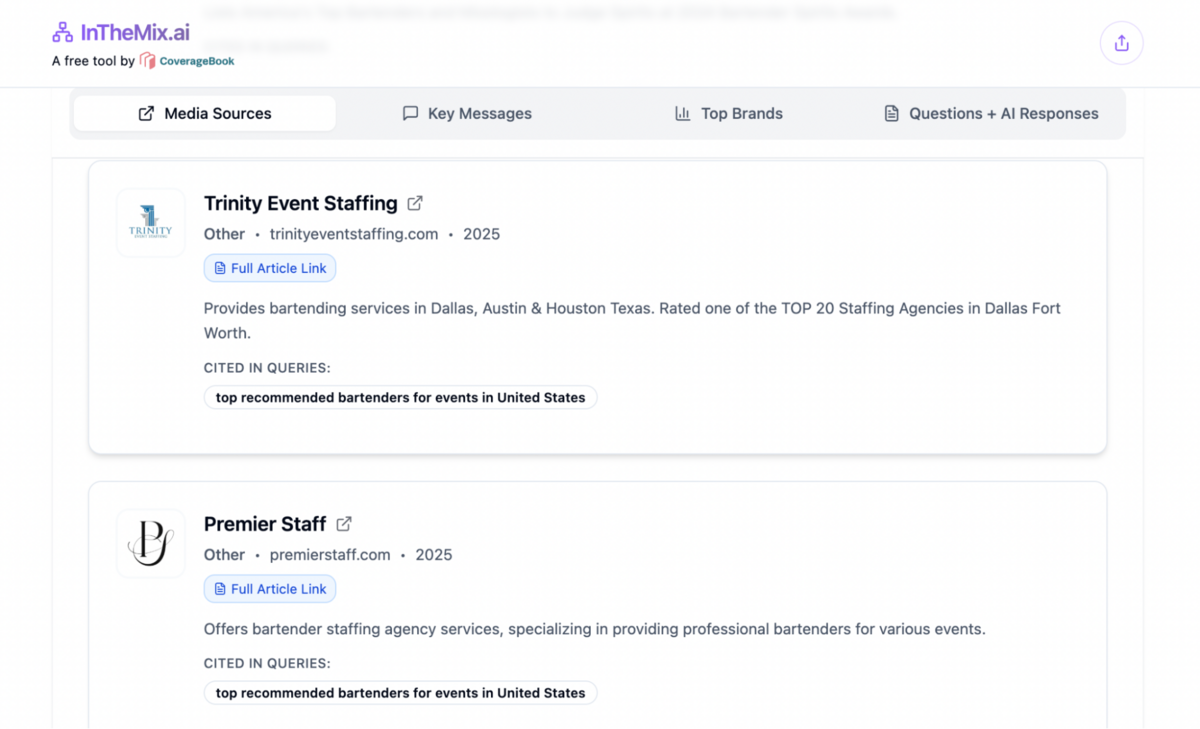
The only downside here is that it’s only five queries, so you are just getting a small snippet of the landscape.
However, the idea is that if you can understand the media sources being cited, you can essentially reverse-engineer them and try to get your brand mentioned in those same sources.
Whether that strategy works is still up for debate.
Pricing
InTheMix is free.
4. ChatGPT for Research and Content Creation

ChatGPT is hands down the best AI tool for researching and simplifying complex topics. As you can see below, journalists and PR professionals in Cision’s State of the Media report utilize ChatGPT mainly for research.
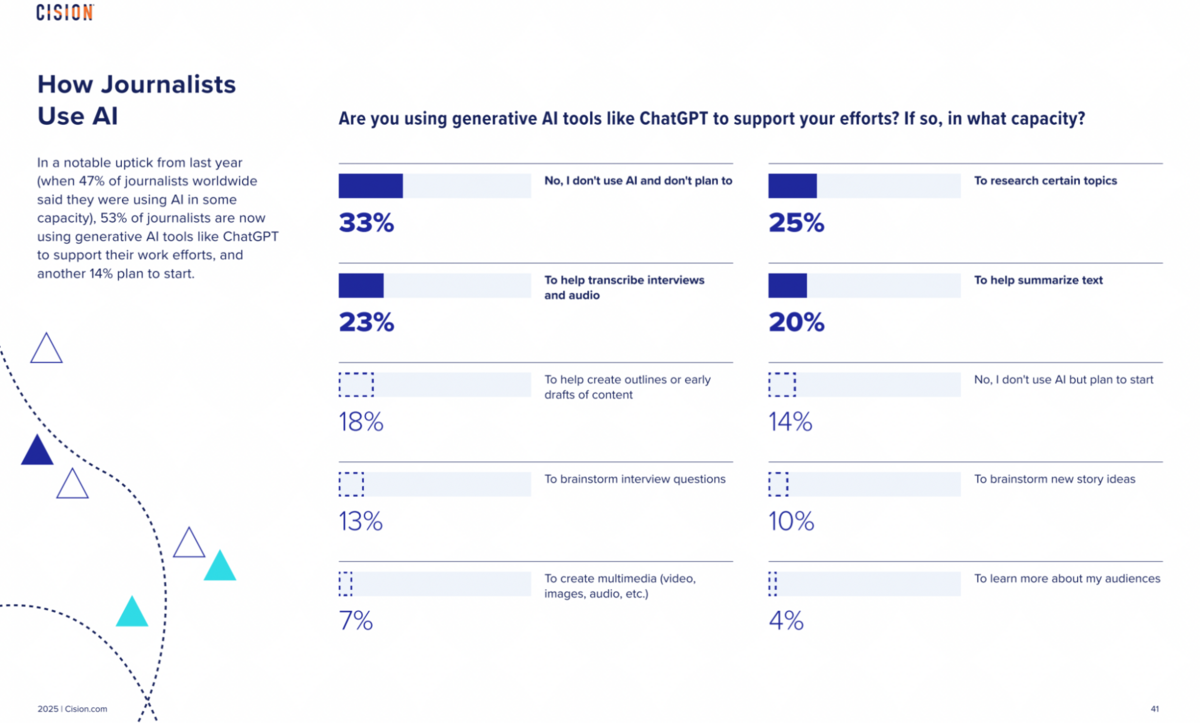
The tool searches the web, gathers relevant information, and summarizes it.
I’ve found it helpful for gathering, compiling, and analyzing data. For instance, here it is helping me find data sources for a city study, a very popular digital PR campaign strategy.
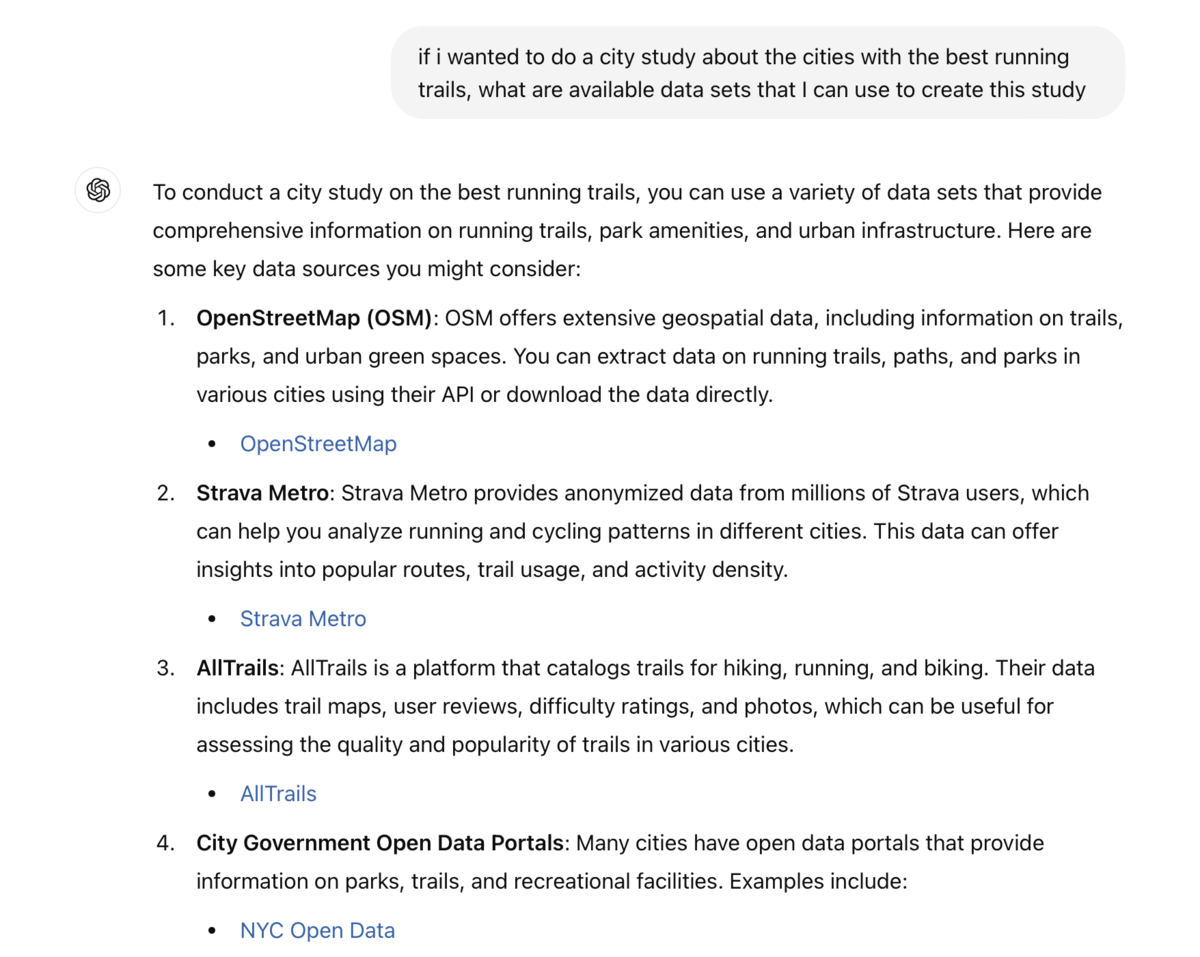
In last year’s post, I talked about the issue of ChatGPT “hallucinating” and spouting false information. These problems are still rampant.
The workaround I always suggest now is to request citations, so I can then conduct further research or confirm the information myself.
In 2025, users will have access to Deep Research, providing researchers with a comprehensive and in-depth exploration of a topic. I’ve found these to be the most trustworthy of all of ChatGPT’s work.
For instance, say I wanted to understand journalist layoffs. I ask the first question with Deep Research enabled and ChatGPT will ask me a few more clarifying questions before it goes off and does research for me:
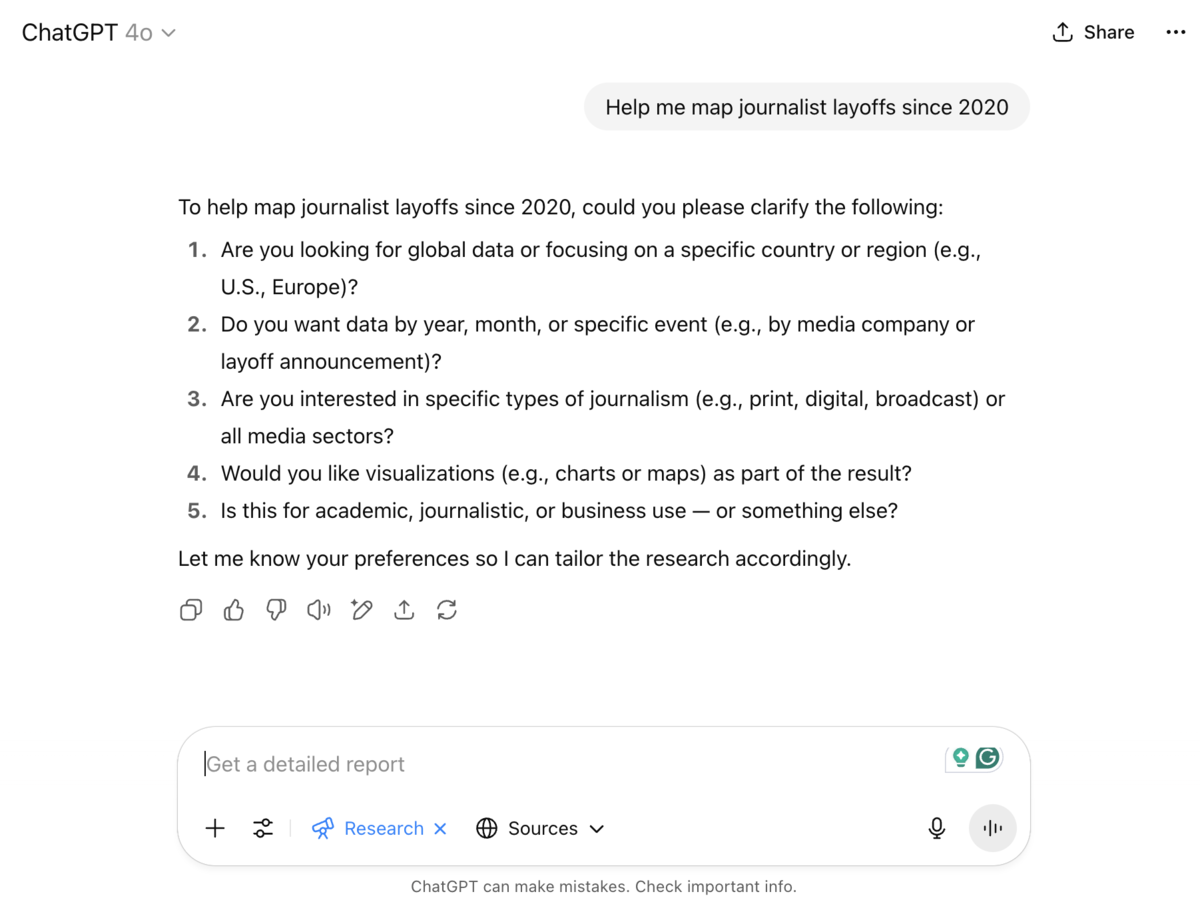
Aside from research, digital PRs have also experimented with using ChatGPT to assist with the coding portion of their work.
Matt Foster from the digital marketing agency Distinctly came onto the BuzzStream podcast to discuss a lot of their efforts to create campaigns using AI and how they’ve implemented it into their workflow. If you’re interested in that kind of thing, I highly recommend giving it a watch:

Steven Brownlie of Reach Creator, an outreach agency for digital and SEO agencies, also started an end-to-end content creation process using ChatGPT for a post about surviving the AI Apocolypse.
In his words:
“Without doubt, AI can enhance your capabilities if you can’t do something, and it can get you results. Would a $10k well-thought-out campaign with a real PR pro have produced more results? Of course it would. Could you get a better result in an hour, knowing nothing about code, PR, linkbait… I would say definitely not.”
Pricing: Free with more limited access. $20/mo for access to the faster and more sophisticated AI models.
Alternatives: Google’s Gemini is the main competitor with ChatGPT. I sometimes use them in tandem to get the best information.
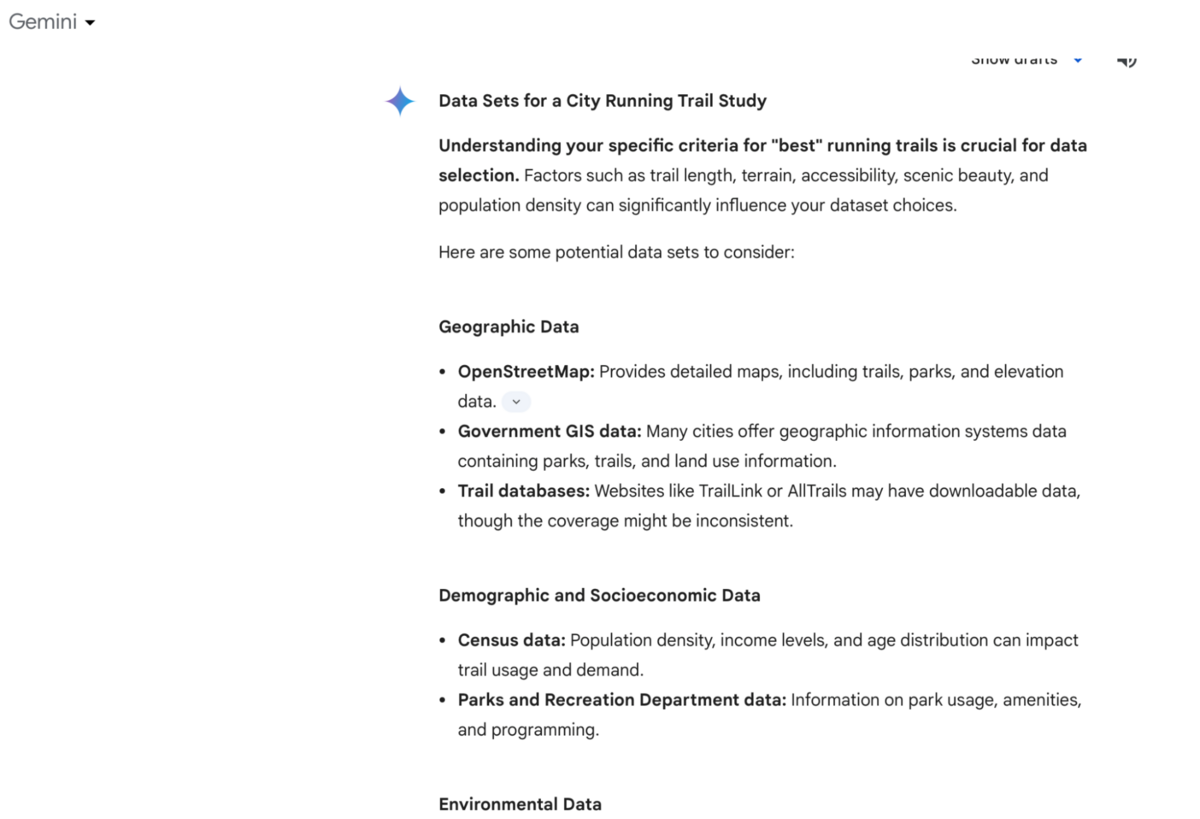
Gemini recently started including citations within its answers, which helps learn more about a topic.
Claude is another notable ChatGPT competitor worth exploring. Following allegations and reports that Google’s AI tools were spouting false information, the company positions itself as more accurate and safe.
Its output is very similar to what you’d find with the other AI tools.
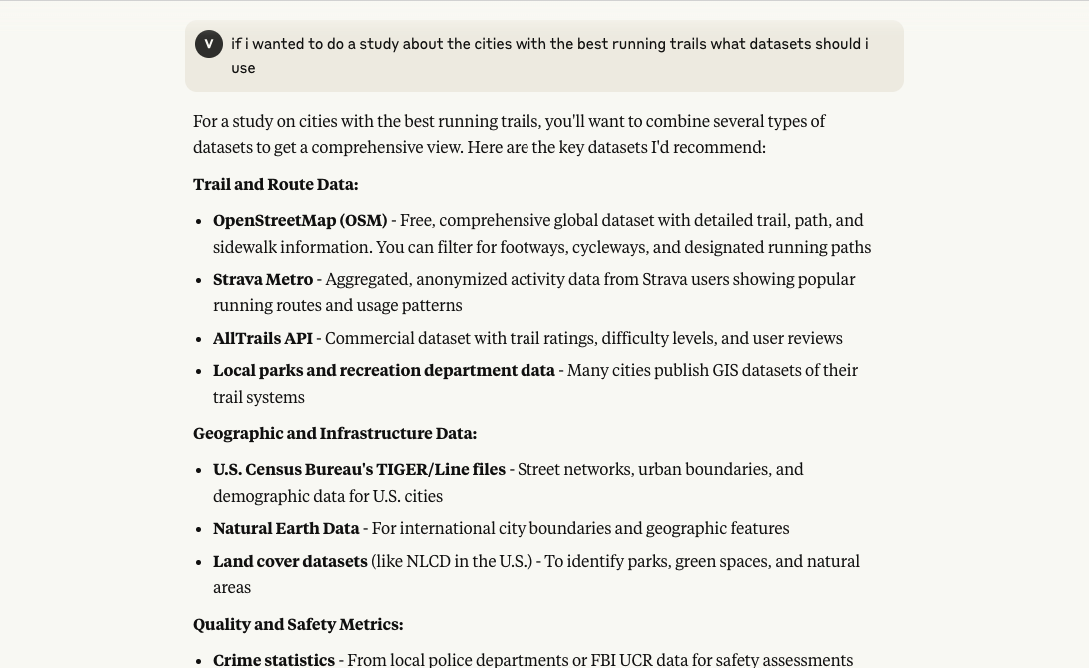
Perplexity is yet another LLM tool, but it acts a little more like a traditional search engine, providing you with citations at the start and then summarizing:
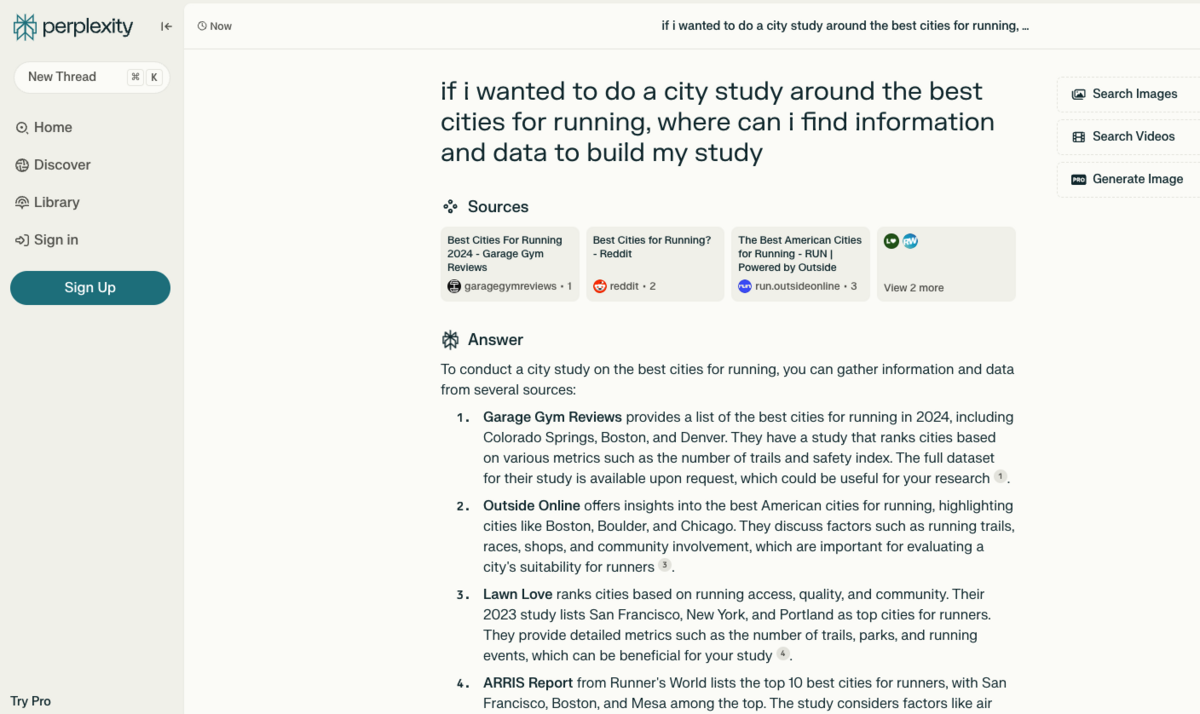
According to Datos’ research, Perplexity has even started to surpass ChatGPT, despite being a much smaller player.
5. Hypotenuse AI Press Release Writing Tool
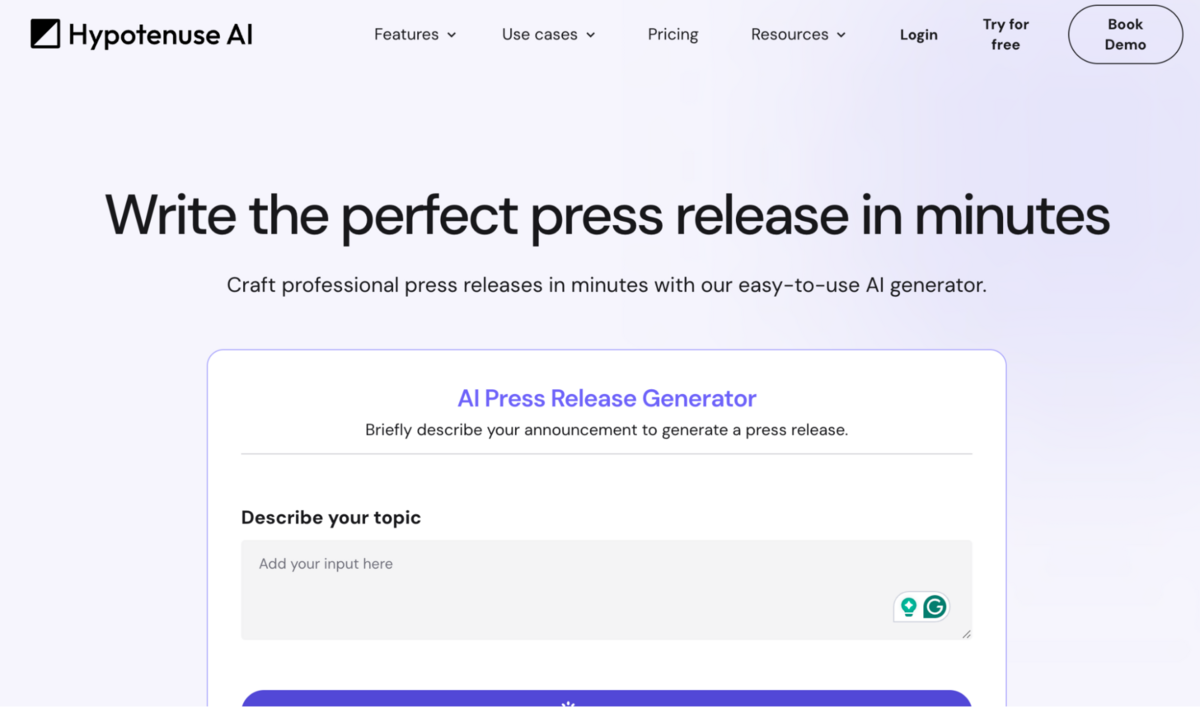
Hypotenuse AI’s press release generator is part of a suite of AI-powered text generation tools. Their press release generator page is misleading, so stay with me.
At first glance, it appears to be a simple text field, which almost made me skip the tool entirely (because it’s no different than just entering a prompt into ChatGPT).
But, when you click to generate, it prompts you to sign up (for free) and takes you to their full press release tool, which is much more robust.

It includes extra fields to help hone your prompt and get more detailed, which amounts to a higher-quality press release.
This is the most straightforward way to create a press release, and it syncs well with everything we outlined
I tried to recreate the press release included in our anatomy of a press release post, and it did a pretty good job:
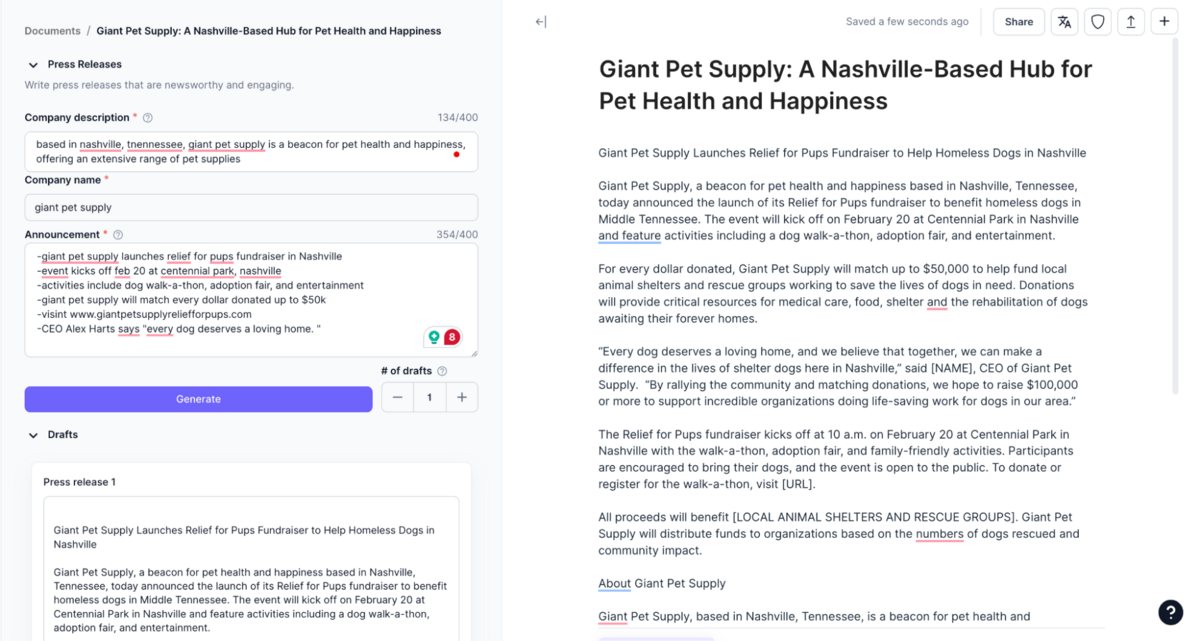
It even added some extra sections to stress some of my points (and made up some information, but I like to use that as inspiration).
No matter what, you must rewrite some of what AI does for you. But, if this saves you time or helps with writer’s block, tools like this can be really helpful.
Pricing: Free 7-day trial, then $19/mo for the lowest tier.
Alternatives:
LogicBalls has an entire suite of hundreds of AI tools, including a free press release tool.
What I like about LogicBalls compared to other press release tools is that they provide sub-categories for more information, including Topic, Quotes, Details, Tone, and Language. However, with LogicBalls, you need to pay for a “premium” quality press release, which sounds more “human”.
OpenAI’s ChatGPT does fairly well with writing press releases, but it all comes down to the accuracy of your prompts.
For instance, saying, “Write me 400 words about the launch of my new pet brand website, Petstore.com,” will get you something very generic.
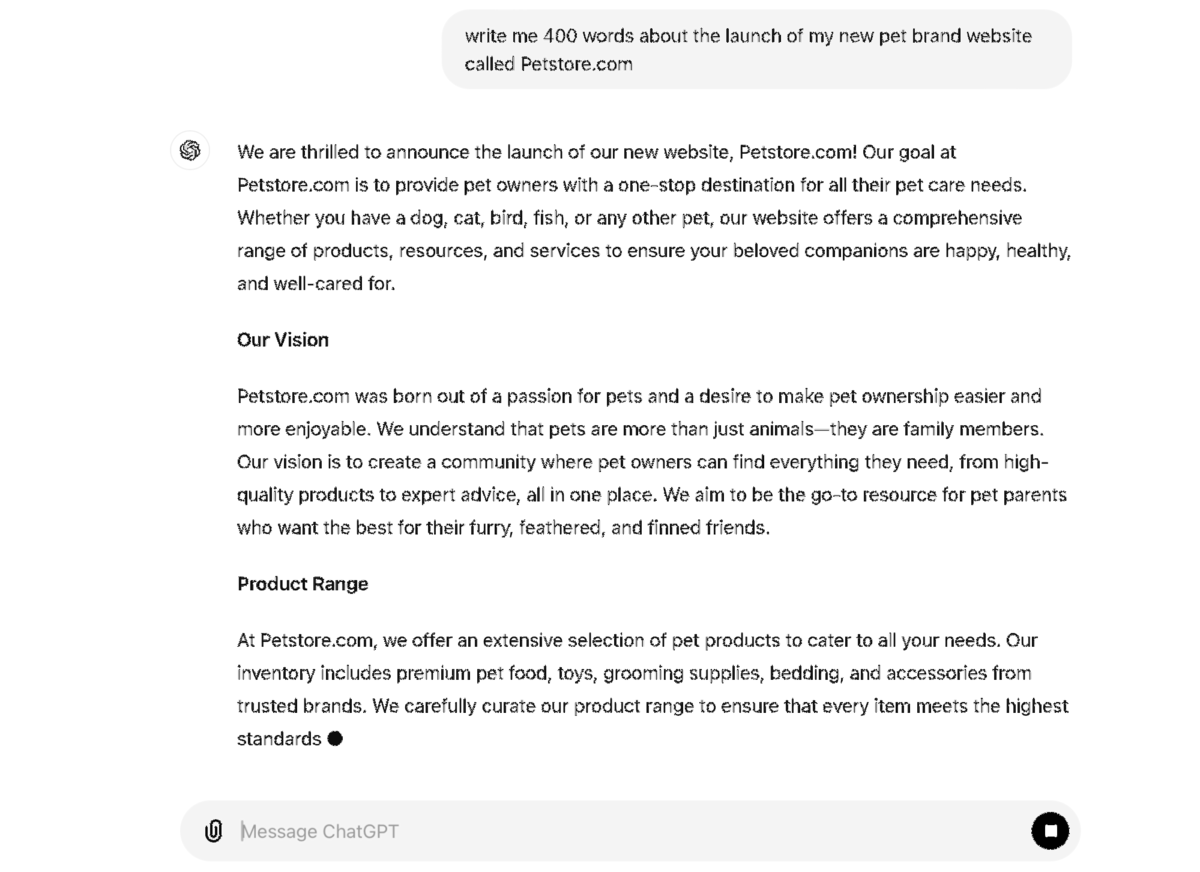
Without specific guidelines and guardrails, ChatGPT will do its best to answer what it thinks you want but won’t get close enough.
Prowly’s process works well because it creates prompts based on the answers to several specific questions, requiring you to drill down on the details.
Tip: No matter what, you’ll want to edit anything an AI tool writes for you.
6. PressPal.ai for Writing a Pitch
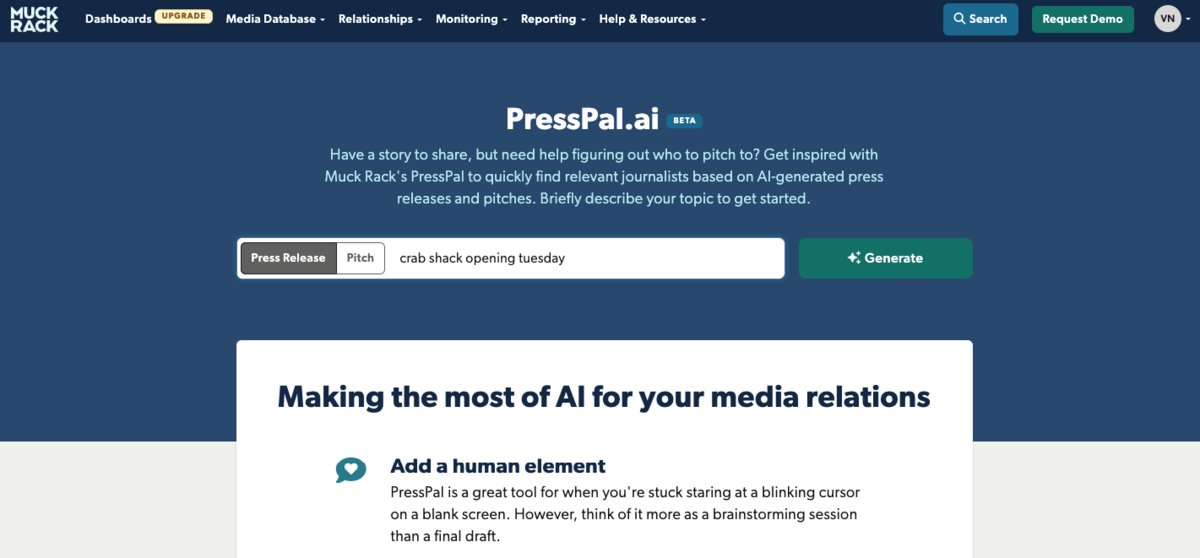
PressPal is an AI-powered tool from MuckRack. It uses AI to write pitches based on a simple prompt. Again, the quality of the result depends on the amount of detail provided in the prompt.
For example, here’s a generic pitch prompt: [crab shack opening tuesday]
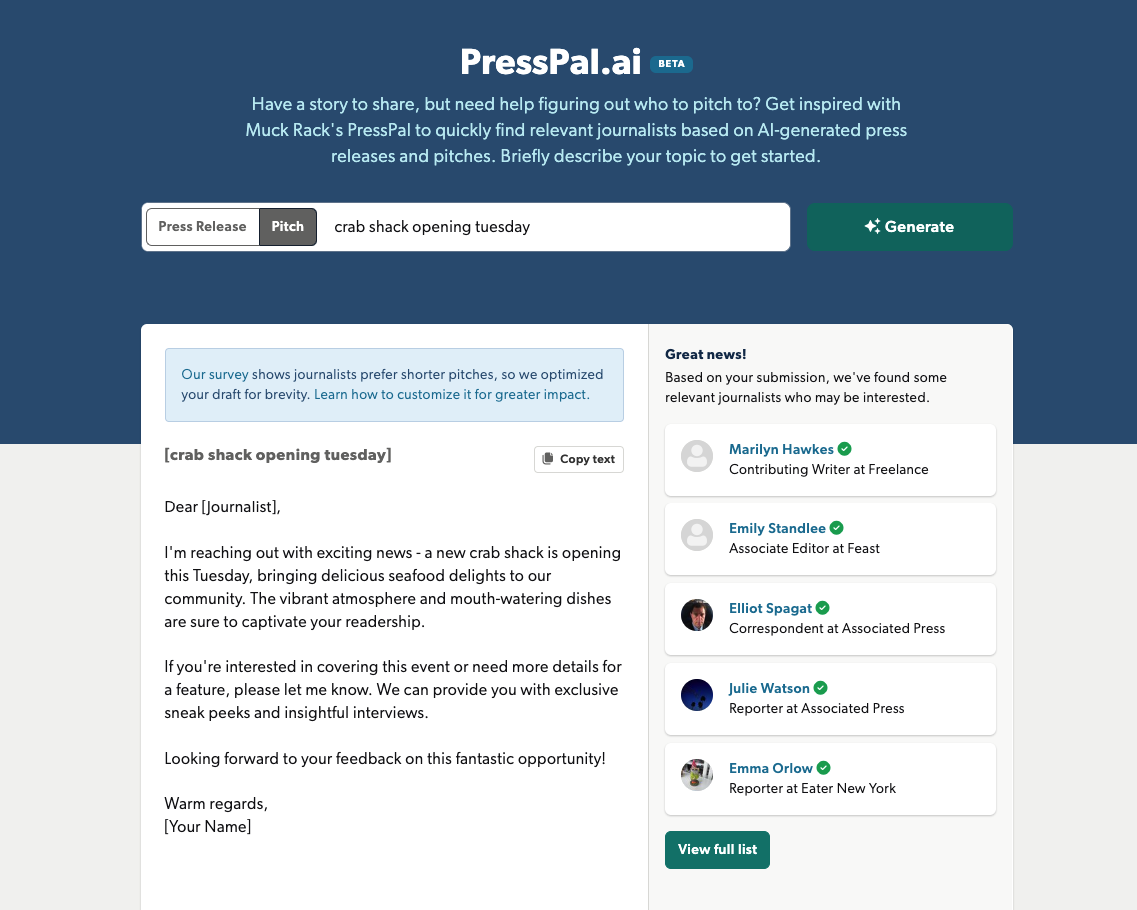
If I give it a lot more information, it can create a more detailed pitch:
[the new Johnny’s crab shack grand opening is tuesday. This is a new joint venture between Johnny Lennon and Pauly McCartney. It features the famous hundred dollar gold-dusted crab fries. Reservations are needed. ]
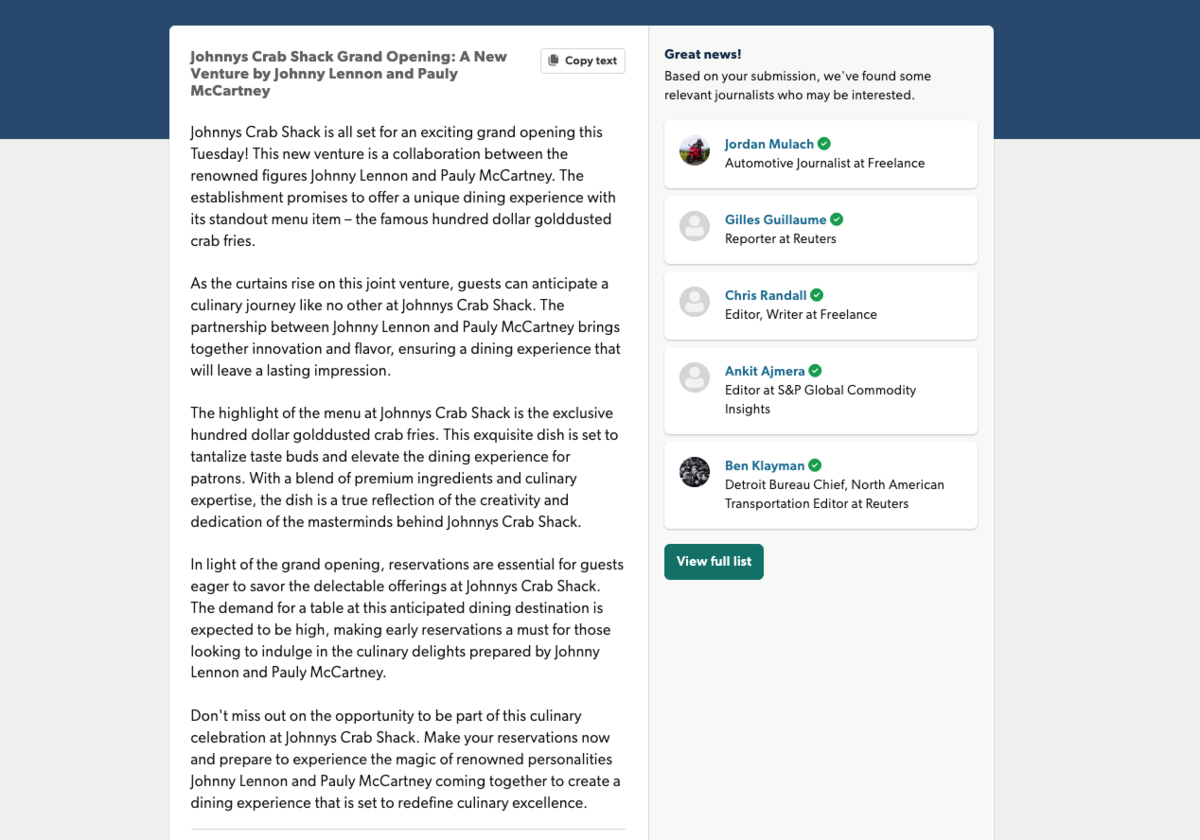
It also provides you with relevant journalists to pitch. (I recommend using the BuzzStream Media List Enhancement tool to ensure they are relevant and current.)
Pricing: Available for free with a (limited) free MuckRack account subscription.
Alternatives:
Again, ChatGPT can do this and most likely power MuckRack’s tool. We used ChatGPT in our AI pitch study and found it was surprisingly accurate with 79% of the respondents saying the pitch was convincing.
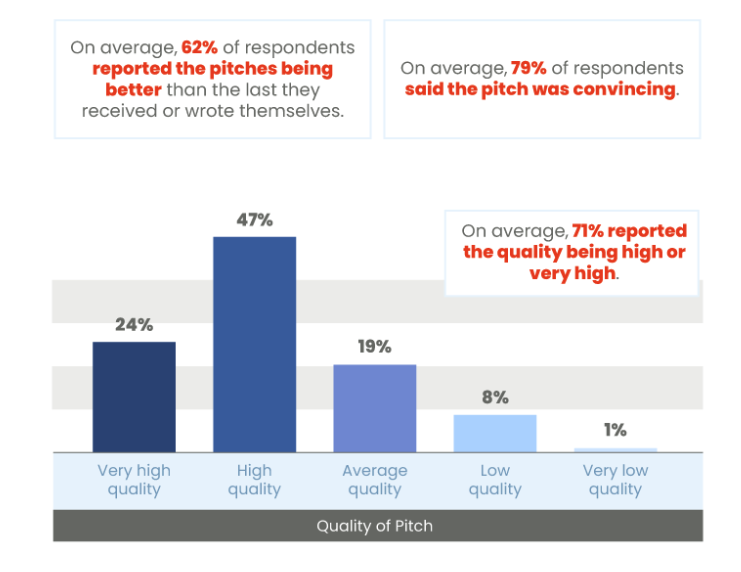
This was back with GPT-3, and at the time of writing, the standard is GPT-4.
PRophet offers a similar suite of AI-powered tools, including a press release/pitch writing tool. Contact them for pricing.
7. IdeaMap.AI for Brainstorming Content Ideas (alternative Gemini)
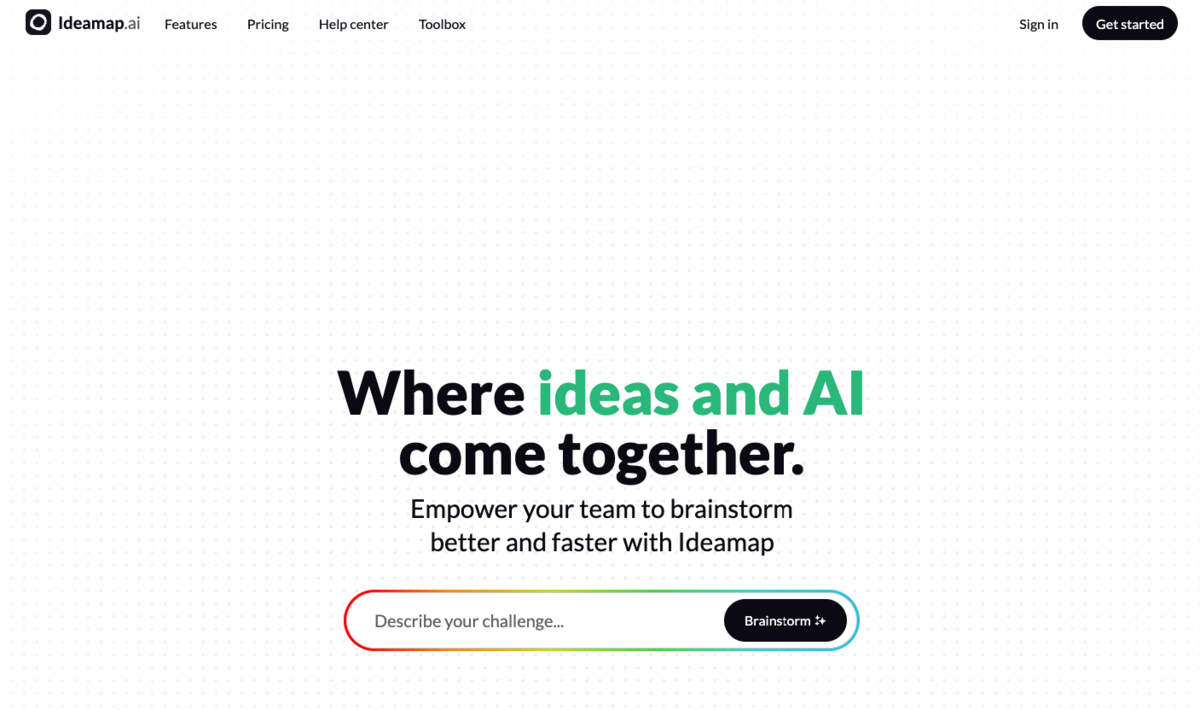
I’ve found that AI is most effective for PRs when brainstorming. Since AI can pull from so much information, it can be a shortcut for idea generation.
IdeaMap.ai is a tool that uses this to help teams (or solo users like myself) generate and visually organize these ideas.
For instance, I asked for help ideating reactive PR ideas for BuzzStream.com regarding the anti-trust ruling against Google.
It created a vast mind map for my ideas. Each is editable and movable.

Zooming in, you can see that it is divided into subcategories such as media coverage, social media strategy, and video content.
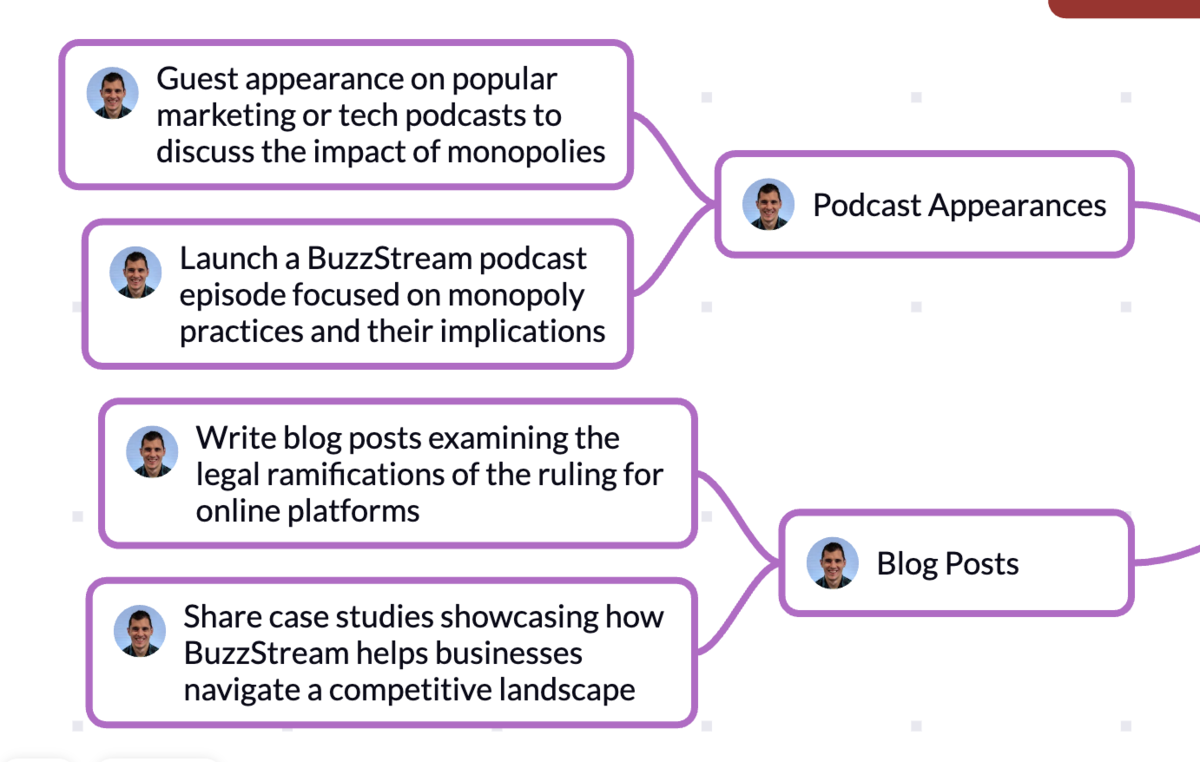
What I like most about the tool is that it allows you to create collaborative rooms with your colleagues. So, you could host a brainstorming session.
Tip: The more specific the prompt, the better the ideas.
Pricing: It is free for up to 5 users in a room. Then, pricing increases based on the number of rooms, users, and AI functionality.
Alternatives:
ChatGPT again!? Believe it or not, most of the tools on this list are powered by ChatGPT, so I’ve found it’s better to go to the source and learn there.
Most of the time, all that’s needed to get started is a list of solid prompts. There is even a marketplace of free GPTs that others have created.
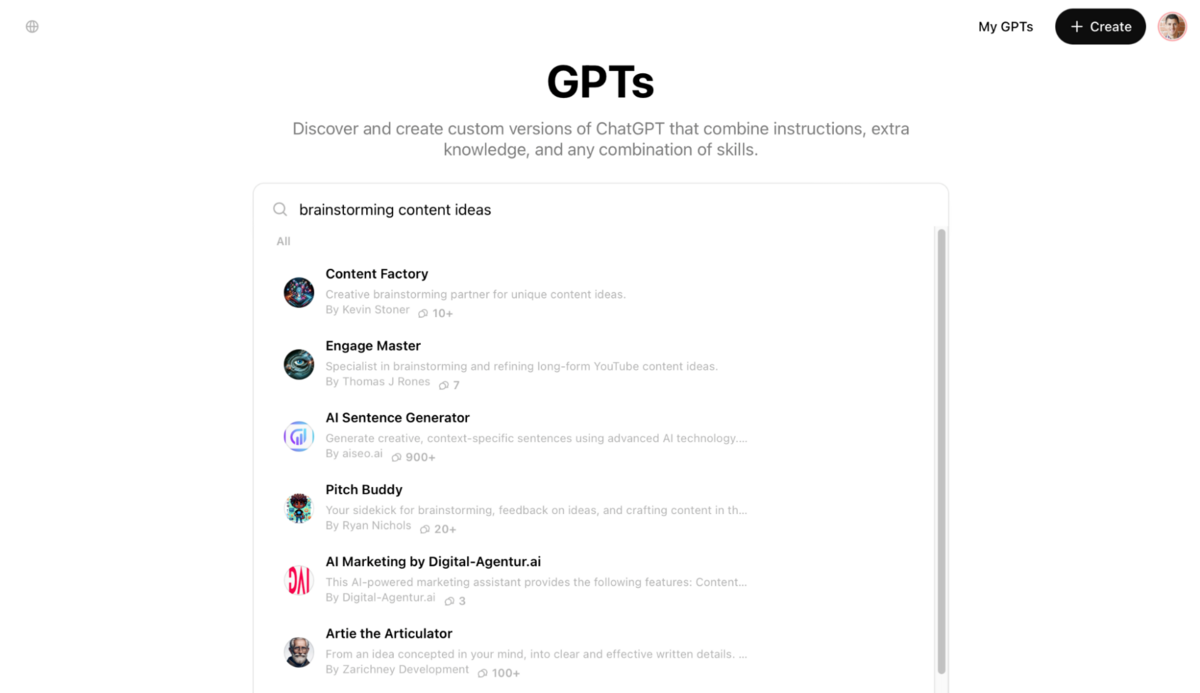
Tip: The quality of public GPTs can be mixed. Use them with caution. You are better off using them as templates to create your own.
8. Canva for Imagery
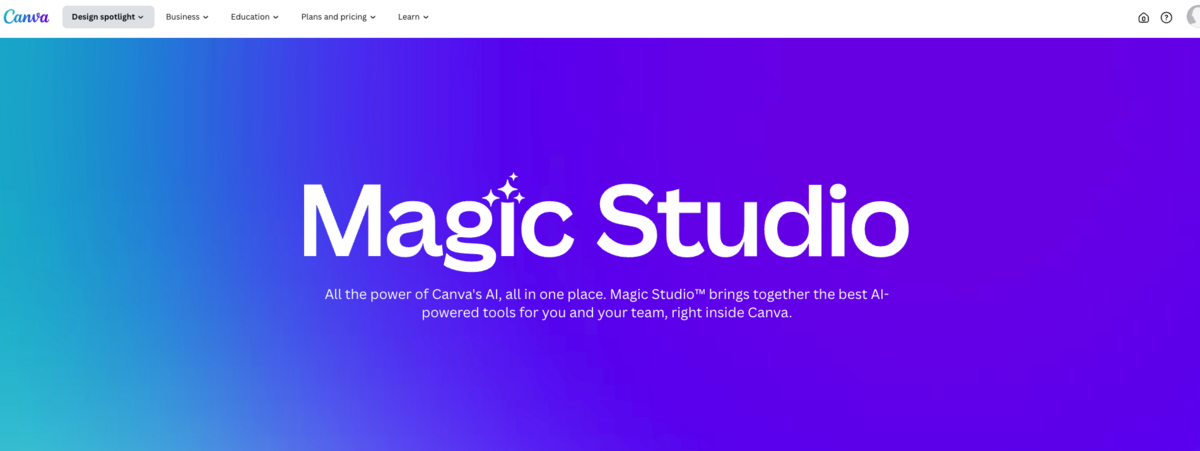
PR campaigns do the best with imagery. In Cision’s 2025 State of the Media report, 70% of journalists used imagery from pitches last year.
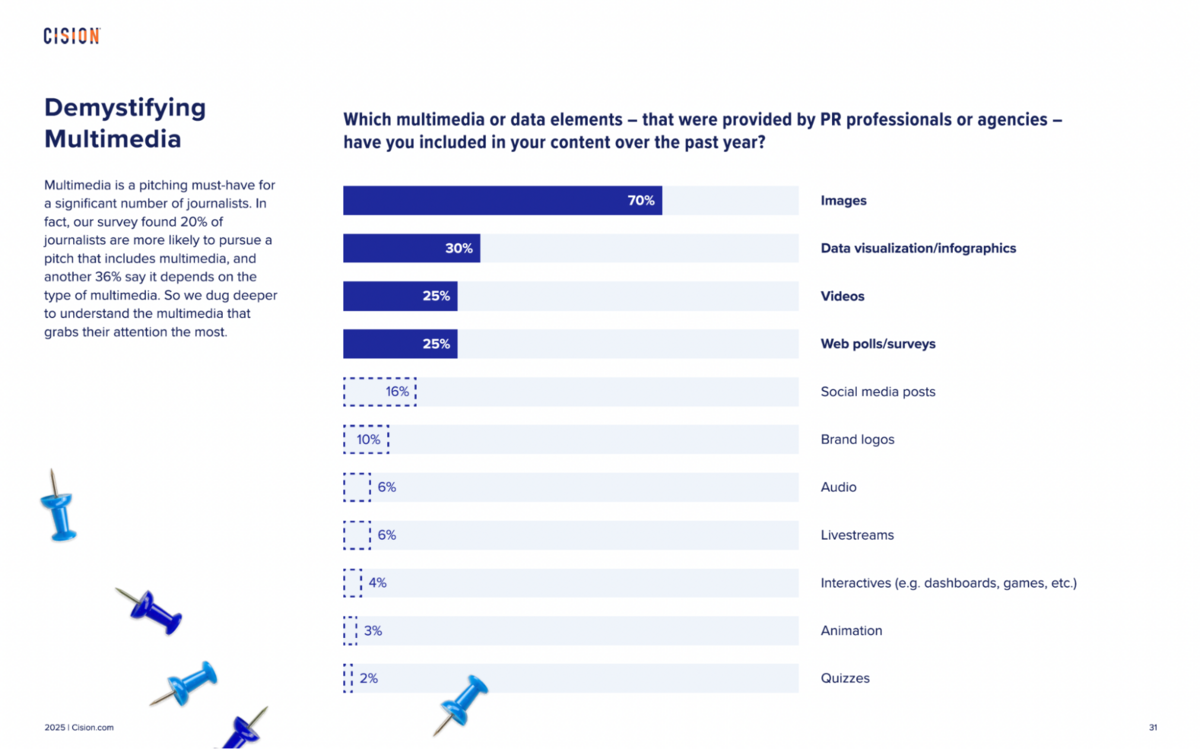
I don’t love using any AI for imagery because nothing beats a solid graphic designer.
That said, I highly recommend Canva’s built-in AI tools, found in their Magic Studio. Canva does a great job of pulling together a series of tools that you can use to edit, manipulate, and create images based on prompts.
For instance, you can create images based on prompts similar to DALL-E or Midjourney:
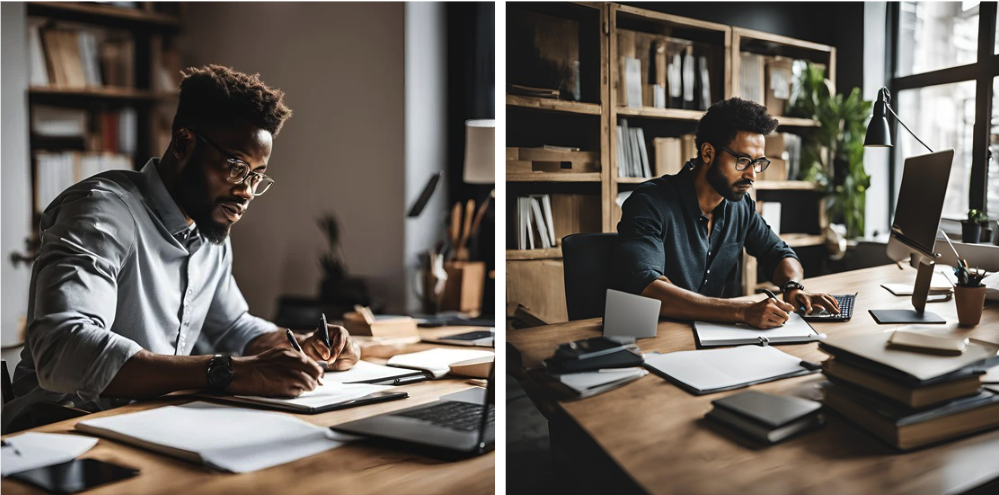
I’ve used Canva for all of our imagery needs for the past eight months and haven’t even begun to scratch the surface of all of the AI-powered effects and tools that Canva offers.

Tip: Some add-on apps require external subscriptions, but it’s worth it if you find one that fits your workflow.
Pricing: The free version has limited features, but I recommend the Pro version getting the full suite of features.
Alternative: Midjourney is most users’ choice for an image generation AI tool.
Victoria Schmid of KURU Footwear talked about how they utilized Midjourney for digital PR campaigns like this one that reimagined U.S. states as shoes:
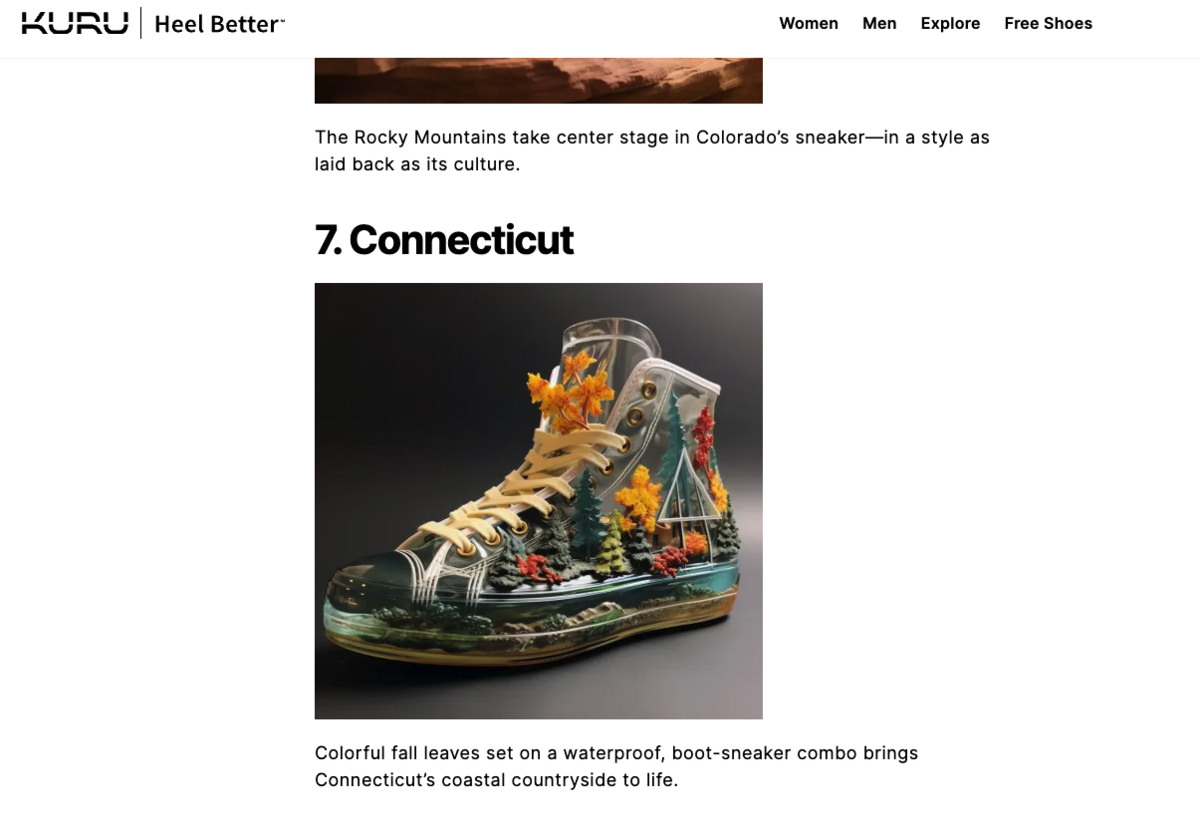
“With new AI platforms like MidJourney, I had the chance to get really creative with this Digital PR campaign. I wanted to try something new and completely unique after seeing some other campaigns using MidJourney, who used AI to show what Barbie houses would look like in each state, for example.
It took some time to get the prompt right (because I purposely wanted to leave it open so that AI would incorporate its elements based on state stereotypes). MidJourney gives four images per prompt, so I then had to spend some time choosing which shoe felt the most compelling for the campaign.
Overall, this was a very fun campaign to work on, and I learned a lot about using AI as a visual element in PR campaigns”.
DALL-E is another offering through OpenAI, and you can access it through a paid ChatGPT account.
I’ve been using it to create a lot of our hero images lately, based on our little BuzzStream man. It does a pretty good job.

While it did an OK job, it didn’t come close to our fabulous designer, Will Zhang.
9. Grammarly For Writing and Editing Content

Grammarly has an AI-driven tool within Grammarly. Think of it like Clippy from Microsoft Word (remember this guy?), only way less annoying and much more useful.
Grammarly works in just about any application—from Google Docs to Gmail.
The AI component helps rewrite in real-time with this little widget:

If you highlight a passage, Grammarly gives you options like improving your text, making it more engaging and descriptive, simplifying it, paraphrasing it, and, my favorite, rewriting for a general audience.
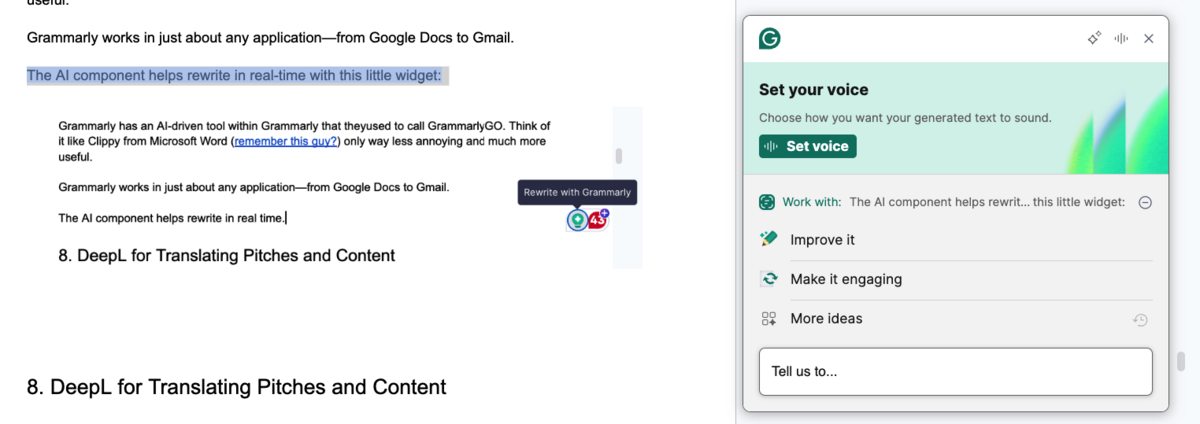
And don’t let the name fool you; Grammarly improves more than just your grammar. You can set voice and tone settings to ensure you write in a way your audience understands.
Grammarly forces me to simplify my writing without dumbing it down. And in the time I’ve used it, I believe I’ve become a much better writer.
Or, I should say, Grammarly pushes me to simplify my writing without dumbing it down. Using it has made me a better writer.
Thanks, Grammarly!
Pricing: There is a free version, but you need a paid subscription to see the impact on your writing. And those start at $12/mo.
Alternatives:
HemingwayApp is my go-to free grammar editor. Recently, they released an AI tool similar to Grammarly.
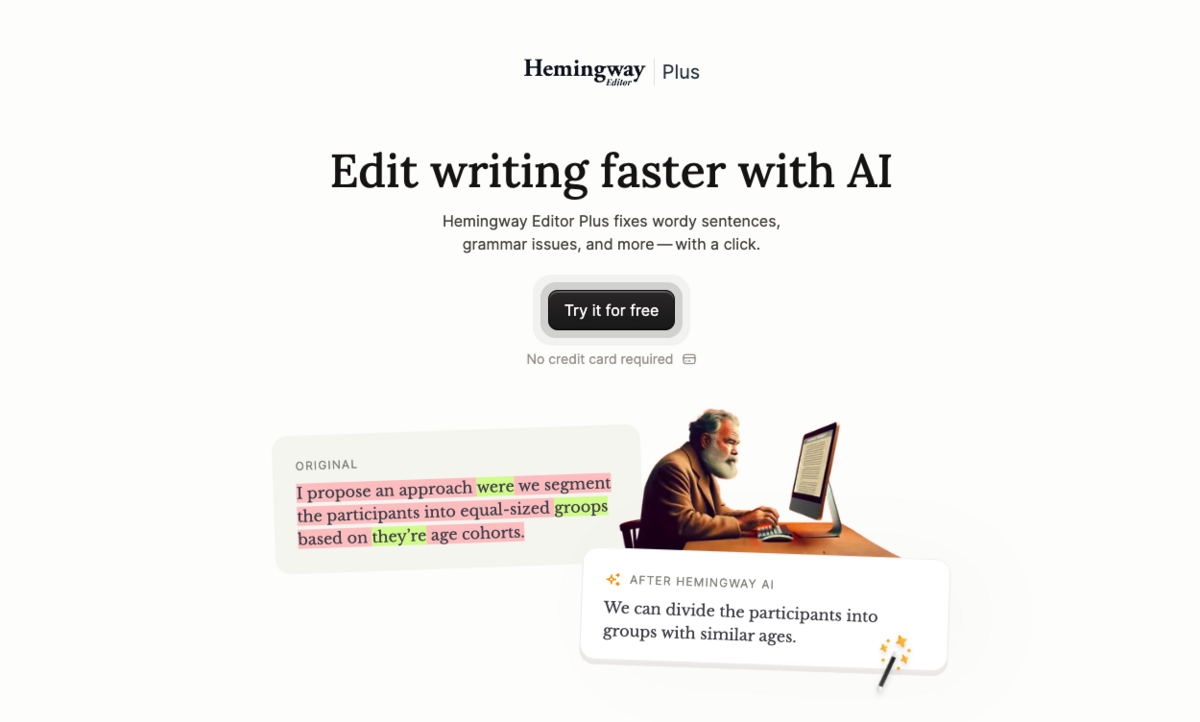
You can do most of the same things, like shorten, rewrite, fix grammar, and more. As you can see, it uncovered some changes that Grammarly hasn’t found, like hard-to-read sentences, or “weakeners”.
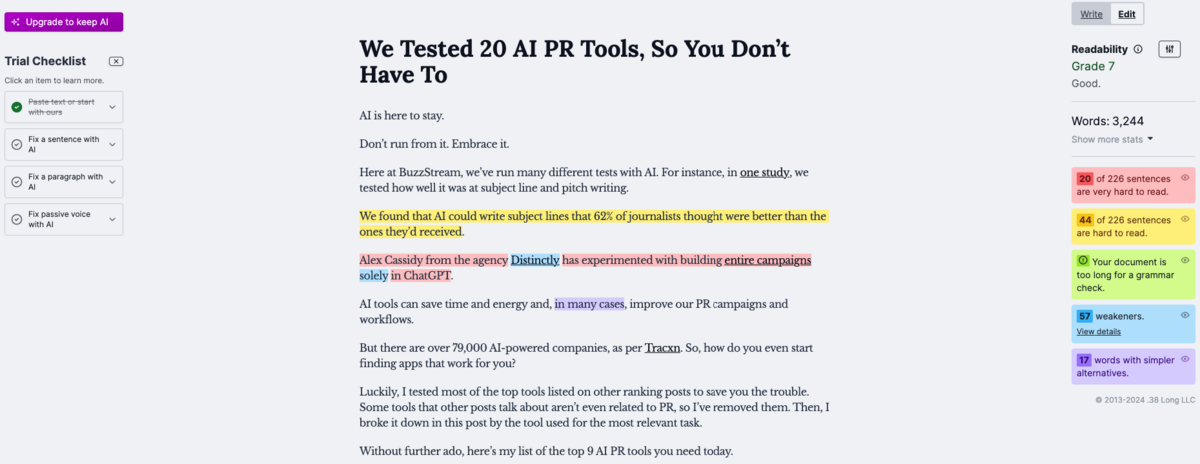
At this point, I mainly like Grammarly because it syncs with Google Docs, Gmail, and other platforms via an extension, whereas Hemingway doesn’t.
10. CopyLeaks for Detecting Plagiarism and AI Writing
While plagiarism and AI writing aren’t the same, they both carry many of the same repercussions, so I would like to group them. For example, in 2022, NBC News fired a political reporter for plagiarizing the works of others.
Some publishers, like CNET or Bankrate, have gotten called out for AI-written content.
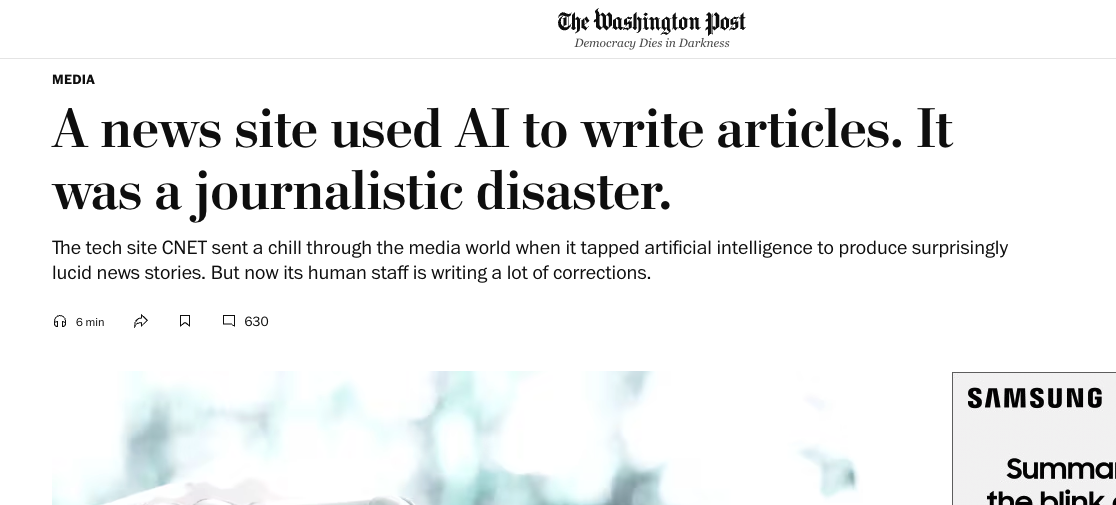
With that out of the way, I like using CopyLeaks for AI detection and plagiarism.
Both are straightforward and free (though free tools have some limitations.)
When I worked at an agency with a freelancer writer, I always ran the copy through CopyLeaks because it was accurate for both evaluations.
For AI detection, here it is using a passage that I generated with ChatGPT:
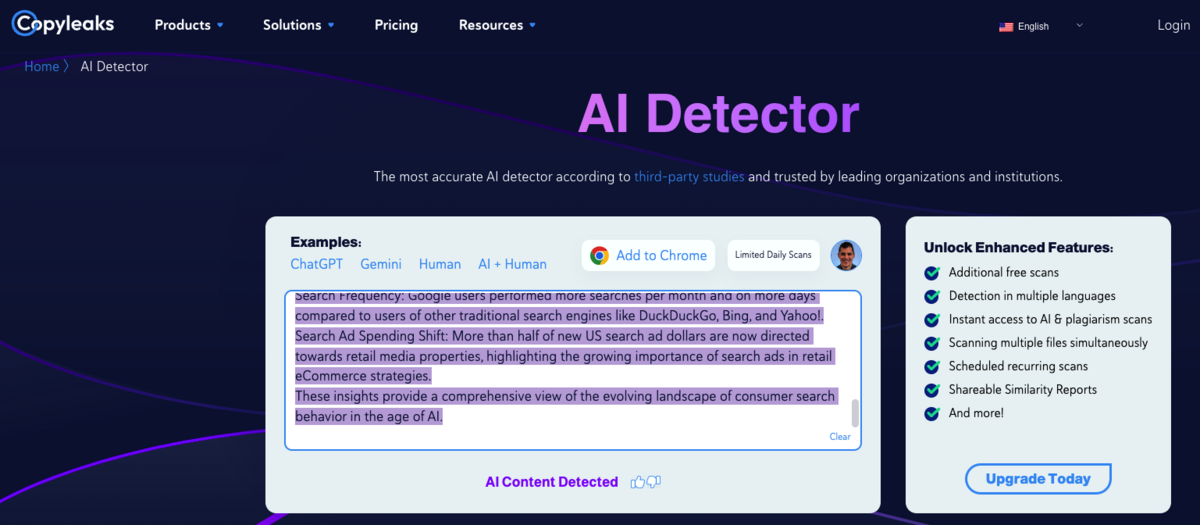
You can see it says “AI Content Detected”.
Compare that to another leading tool, ZeroGPT, which found that the text was surprisingly 0% AI written:
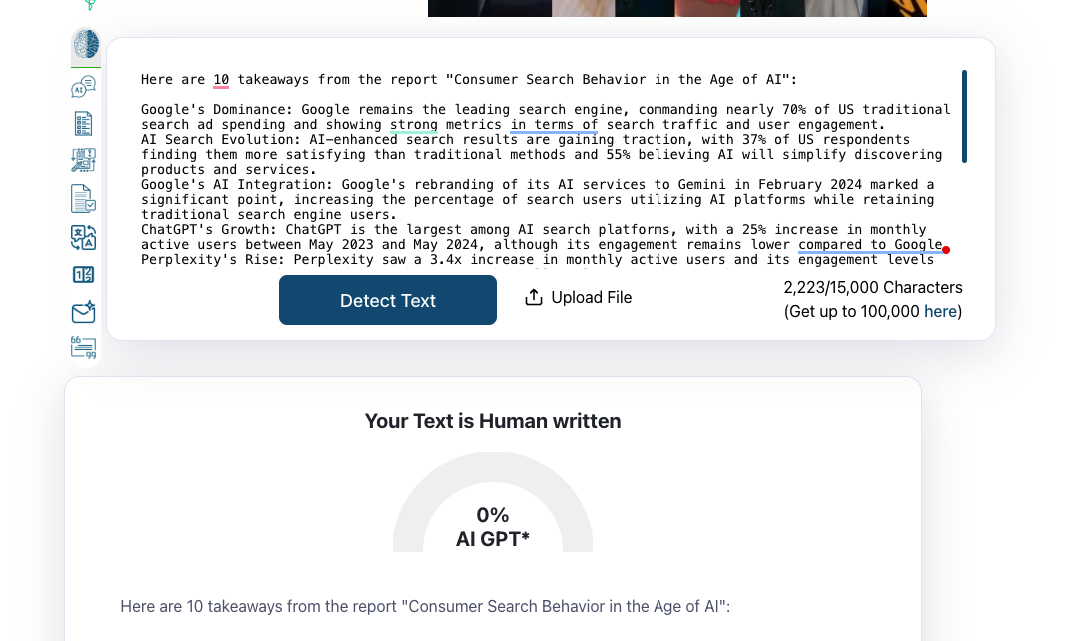
Then, for plagiarism, let’s compare the CopyLeaks checker to Grammarly’s free plagiarism checker.
Below, you can see that CopyLeaks correctly detected 100% plagiarised content.
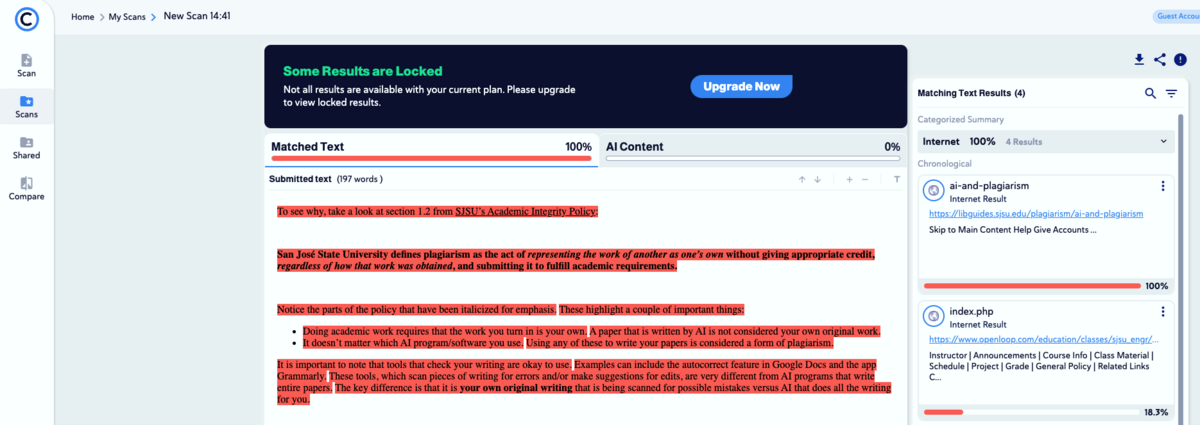
While Grammarly only (incorrectly) detected a 35% match.
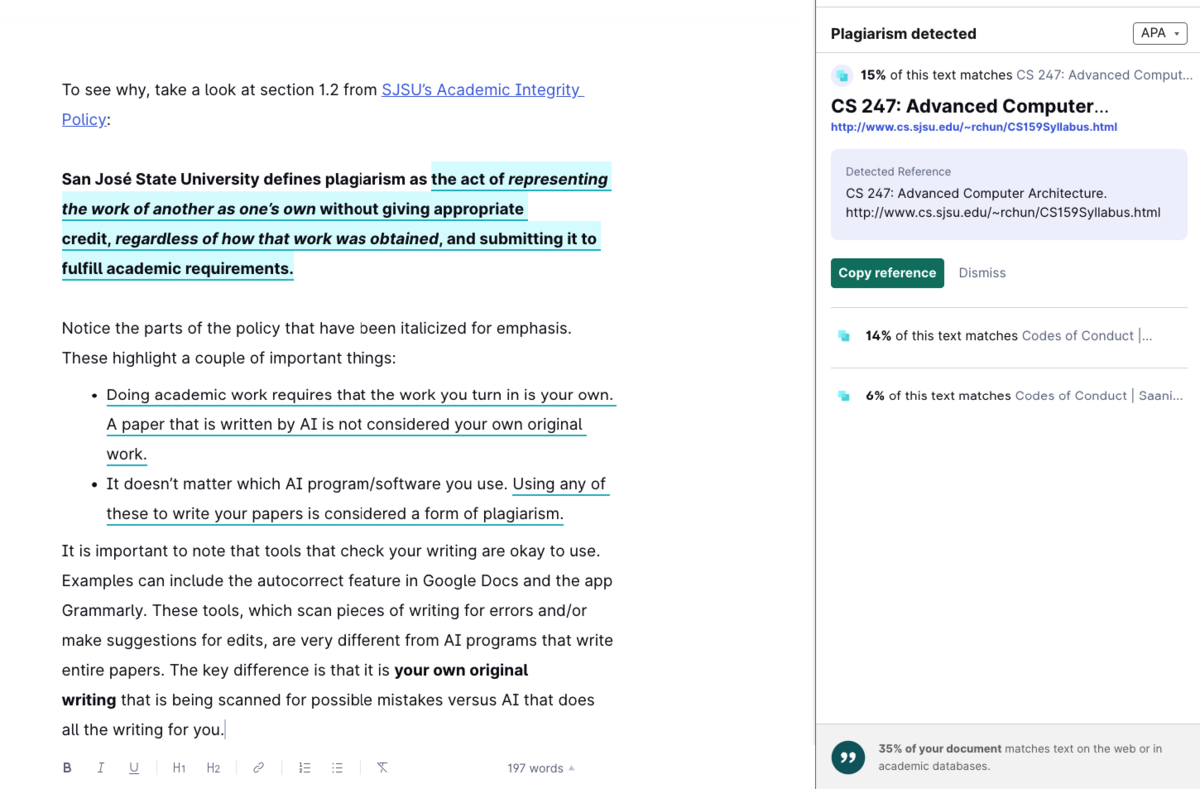
There are a few caveats to be aware of with these tools. Journalists have uncovered programs in which Google pays publishers to churn out AI-written news content, rendering these tools moot.
The other is that while these AI-driven plagiarism and AI detectors are helpful, they aren’t foolproof. For instance, I’ve read numerous examples of employees getting fired for using AI even after claiming they didn’t know what AI was or how to use it.
Pricing: CopyLeaks is free but has limitations on the free plan. I recommend upgrading to a paid plan of $13.99/mo for AI and Plagiarism detection to get the most out of the tool.
Alternatives: Of the tools I tested, Winston.ai came second in detecting plagiarism at 92%.
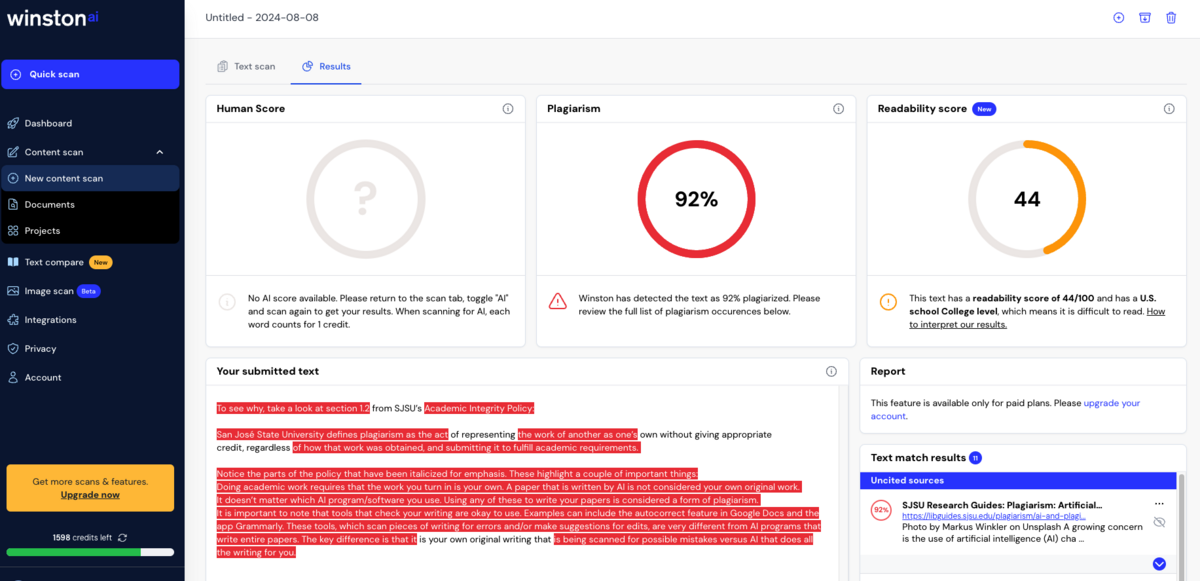
Compare that to PapersOwl (83.4%) or PlagiarismDetector (70%).
What I like about Winston is that it also has an AI detector, which scored perfect in detecting AI-generated content that I fed into it.
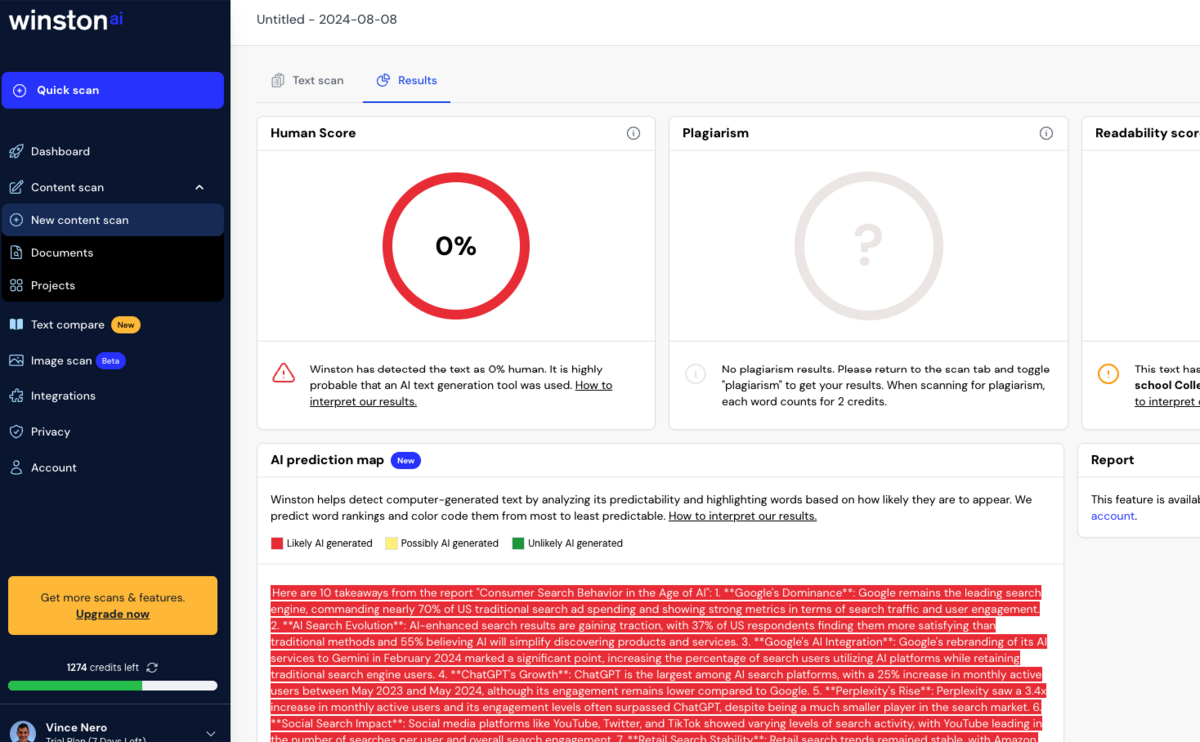
Winston has a free seven-day trial, with some extract features unlocked starting at $12/mo.
11. DeepL for Translating Pitches and Content
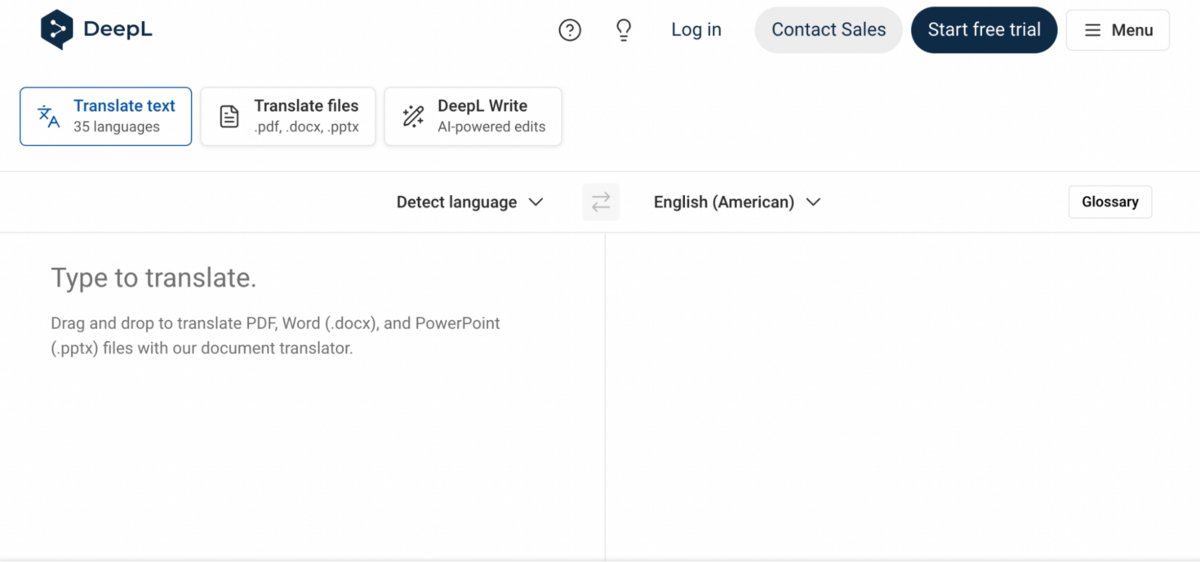
Pitching internationally can be a challenge if you aren’t prepared, but it can also drastically increase the coverage and reach of your campaigns.
Of the ones my team and I tested, DeepL was the most accurate. Our Polish team members gave it a 9/10 in terms of how comfortable they would pitch this to a journalist compared to Google Translate (8/10) and Quillbot (7/10).
For instance, here’s the tool at work translating some of the media pitch examples in our post on the topic:
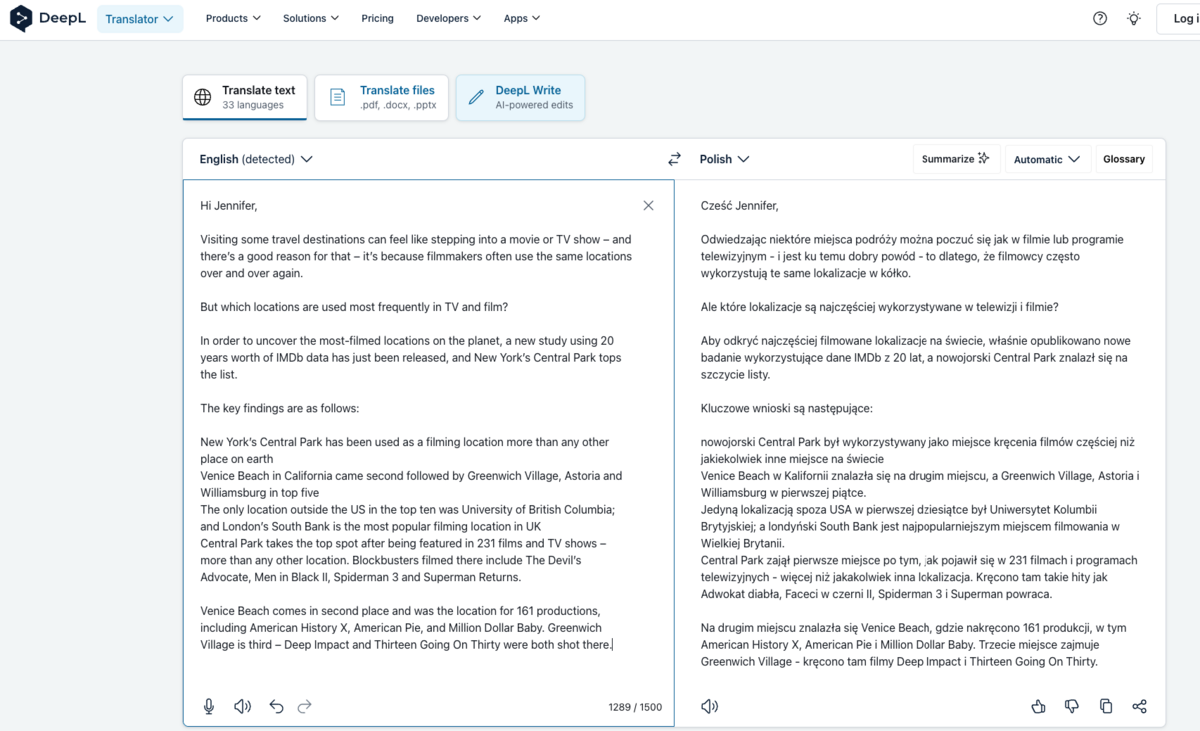
However, a 9/10 isn’t 10/10, and to be successful pitching internationally, you should really have someone who speaks the language natively double-check.
I spoke with Hana Montgomery, founder of Digital PR agency ShoutBravo, who said:
“If you decide to use a translation tool, make sure you take an extra step and have your translation checked by a native speaker.
You want to ensure your translation is spot on, especially if it’s being used for outreach.
Tools can do a lot of the heavy lifting but not always the perfect finish, so it’s always good to have a ‘real human’ double-check copy you plan to use. It’ll also keep you calm knowing you have had a text you, perhaps, don’t understand as it’s not in a language you speak checked by a professional.”
Pricing: Translation is free. The other tiers on their pricing page seem more for businesses looking to translate at scale and give you access to things like an API.
Alternatives: Our Polish team ranked Google Translate a close second to DeepL. Google Translate is free.

Our team stressed that the Google Translate text above gave off “Google Translate vibes,” which many are familiar with after receiving too many Google Translate pitches.
Then, there was Quillbot, which is also free (though it has many other features, like AI detection and a plagiarism checker).

Quillbot did a good job, but not quite as good as the other two in sounding natural.
12. Fireflies AI for Virtual Meeting Transcription
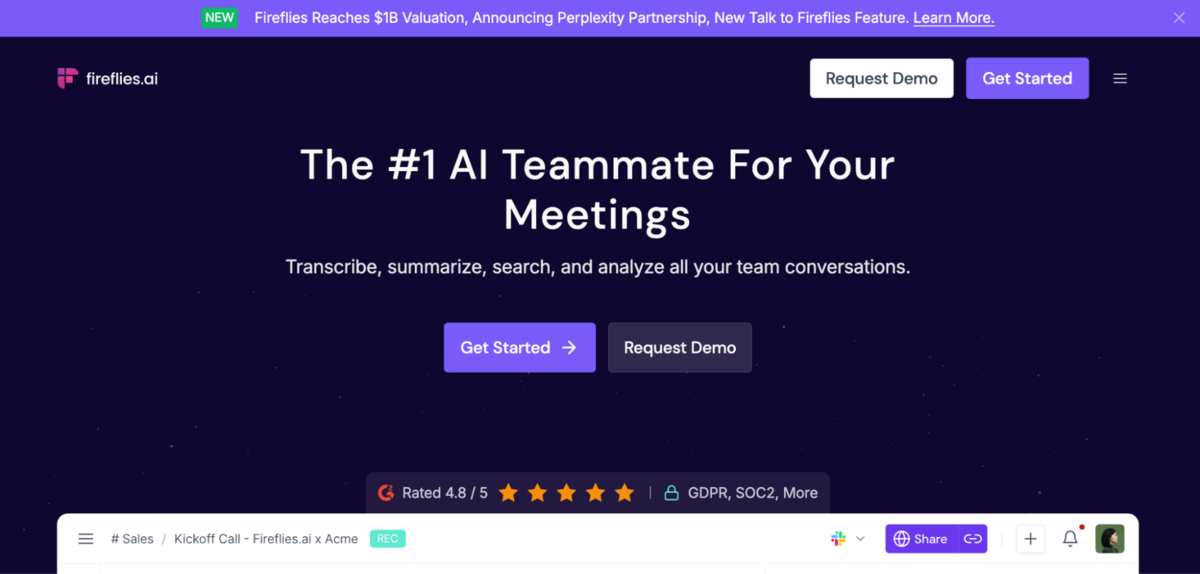
Interviews and meetings are essential for both journalists and PRs. However, when I am focused on taking notes, I can’t entirely focus on my guest.
Fireflies is an AI meeting transcription tool that syncs with various meeting platforms, like Zoom, Google Meet, Webex, and more.
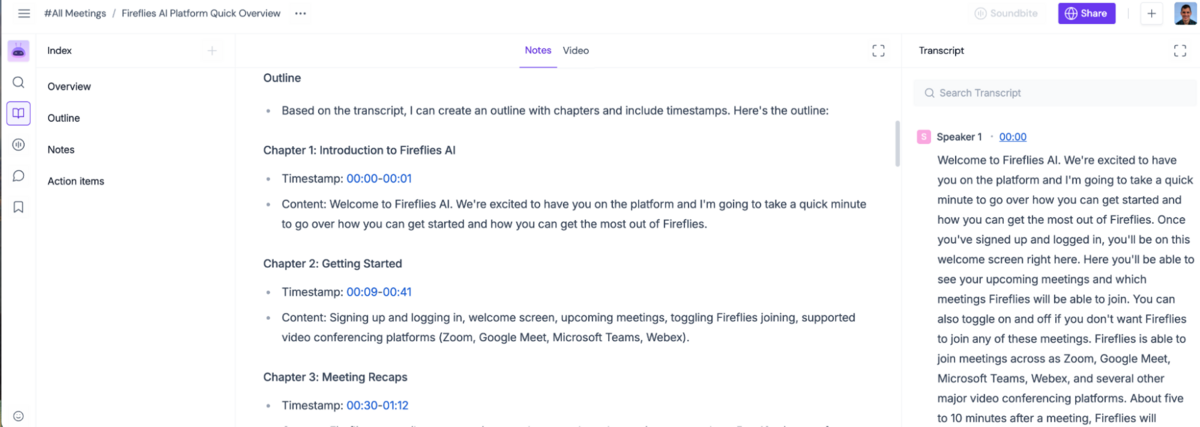
The tool not only transcribes all of the audio with timestamps but also creates an outline, generates important sound clips and has a GPT-powered chatbot that you can use to ask questions about the meeting’s contents.
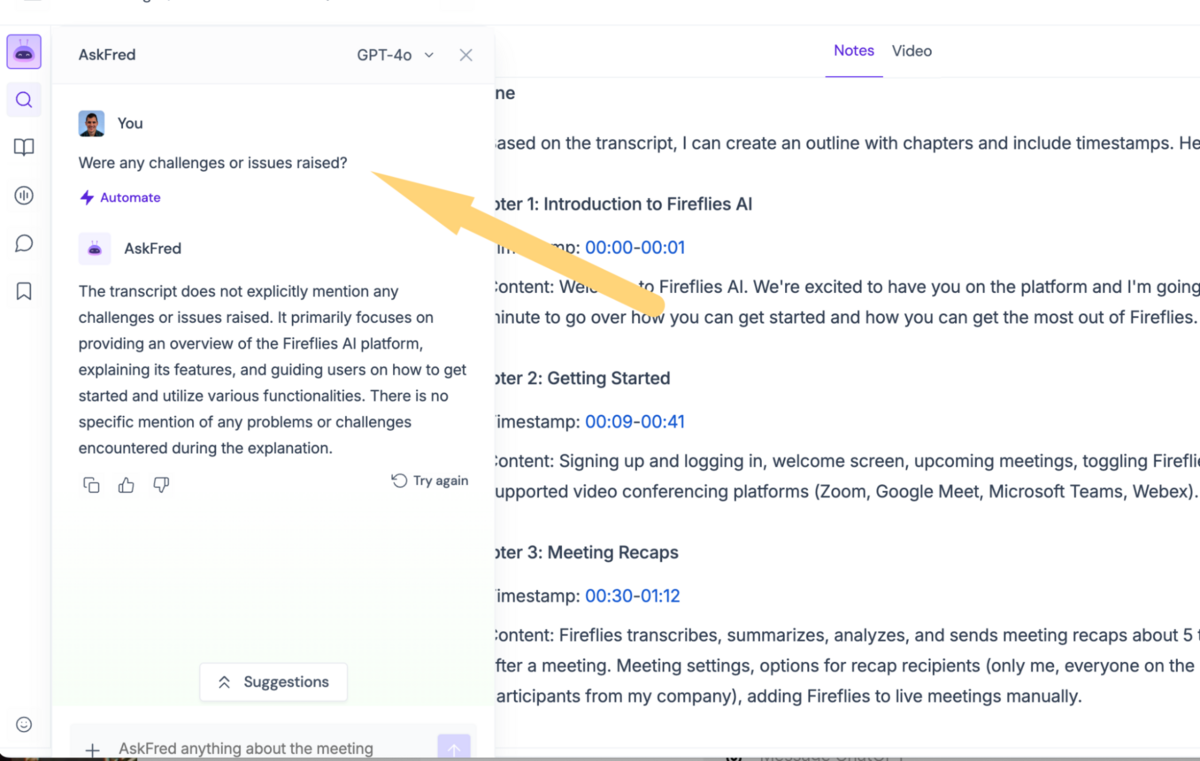
Some other transcription tools don’t automatically sync with your meeting apps and require you to invite them like guests. I find this feature frustrating because I often forget, and it’s too late by the time I remember.
They’ve recently announced a partnership with Perplexity to bring “real-time web search to meetings,” as per their press release.
Pricing: Free version and seven-day trial for higher-tiers with more features.
Alternatives: Most of the online world uses Zoom and has a similar AI-powered transcription feature set.
Take AI With a Virtual Grain of Salt
In my opinion, AI has a long way to go before it can reliably replace a human. Every LLM has some sort of disclaimer warning you to double-check the results like the ones you see below:


But, for simple tasks, these can save an amazing amount of time. Brainstorming is my favorite use case for AI. Still, I’ve also used it to compile tables from text, analyze PDF documents, help me analyze data (regex anyone?), and even summarize large legal documents, like Google’s deposition transcriptions.
As I said in the intro, AI is here to stay. In the long run, the professionals who work with it instead of against it will win.
Interested in more tools? We also reviewed link building tools, digital PR tools, and blogger outreach tools.

 End-to-end outreach workflow
End-to-end outreach workflow


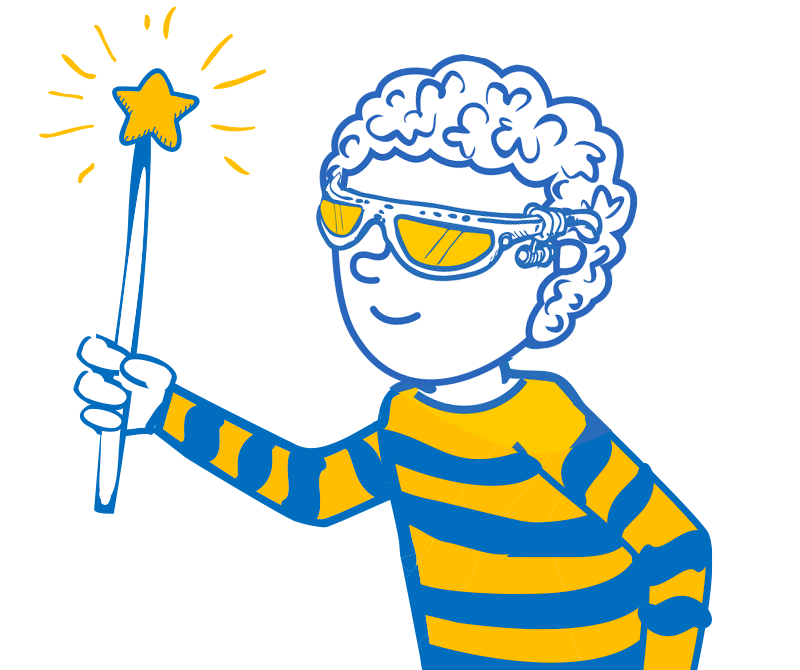
 Check out the BuzzStream Podcast
Check out the BuzzStream Podcast







